the EAGLE
How inclusive is our excellence?
As AU reaches towards inclusive excellence goals, students want to see more faculty diversity p.6
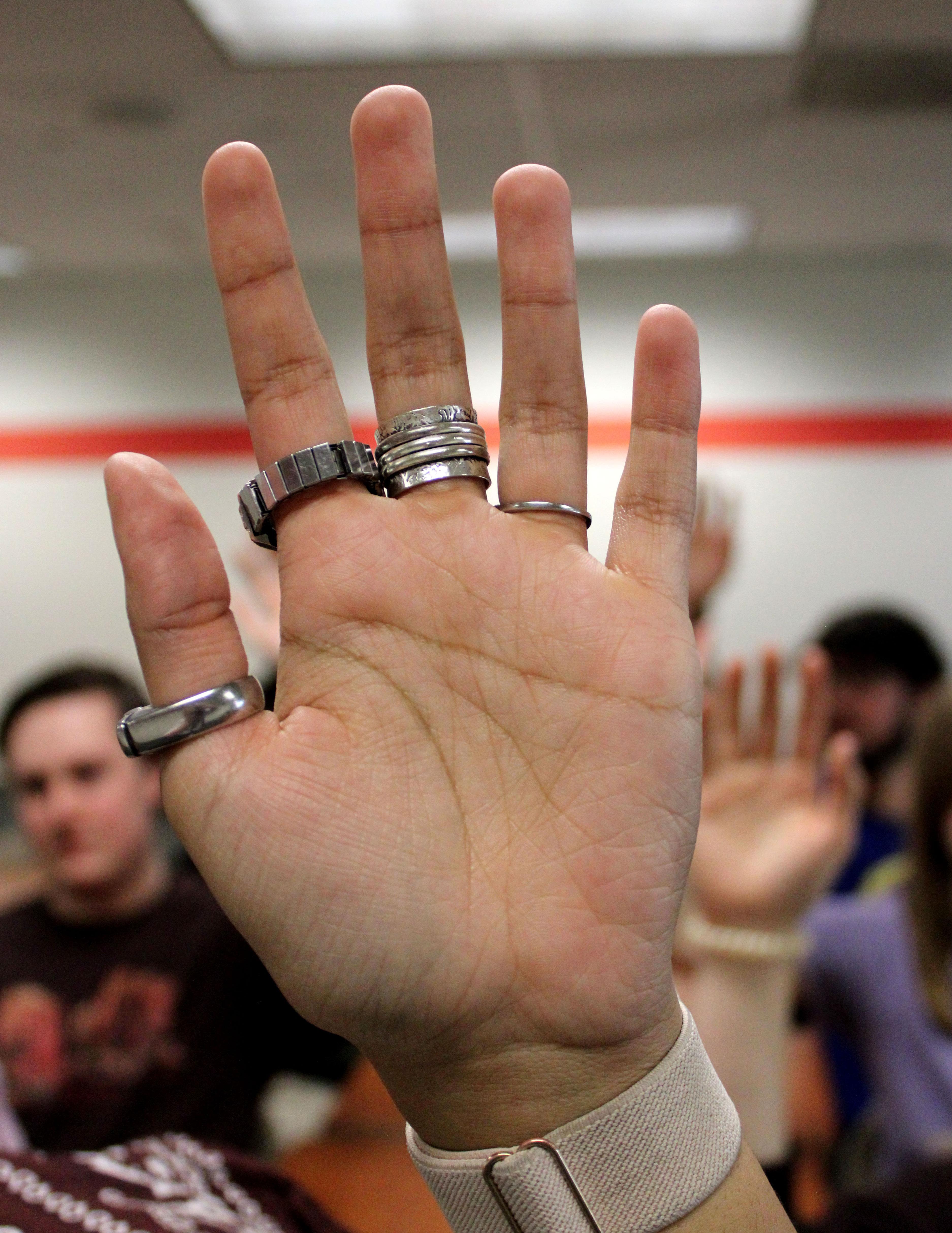
April 2023 THEEAGLEONLINE.COM @THEEAGLEONLINE
Editor-in-Chief
Nina Heller
Managing Editor for Online
Rebecca Oss
Managing Editor for News
Jordan Young
Managing Editor for Life
Kylie Bill
Managing Editor for Sports
Delaney Hoke
Managing Editor for Opinion
Alexis Bernstein
Managing Editor for El Águila
Daniella Jimenez
Managing Editors for Multimedia
Carly Johnson
Izzy Fantini
Managing Editor for Copy
Isabelle Kravis
Business Manager
Eddie Rogers
Assistant Copy Editors
Leta Lattin
Luna Jinks
Natasha LaChac
Sarah Clayton
Saraí Batallas
Sophia Rocha
Sophie Meyers
Stella Guzik
Leva Amoui
Emilia Rodriguez
Assistant Online Editor
Neev Agarwal
Assistant Operations Editor
Taraji Ellingon
Social Media Editors
Aaron Russell Sachi Carlyn Lozano
CONTACT US
NEWS
news@theeagleonline.com
LIFE
life@theeagleonline.com
SPORTS
sports@theeagleonline.com
NEWS news@theeagleonline.com
LIFE
life@theeagleonline.com
SPORTS
sports@theeagleonline.com
MULTIMEDIA multimedia@theeagleonline.com
El ÁGUILA elaguila@theeagleonline.com
BUSINESS
businessmanager@theeagleonline.com
opinion@theeagleonline.com
theEAGLE
Delivering American University’s news and views since 1925 MASTHEAD
Sarah Flakus
Tiffanie Roye Photographers
Maddie Miller
Gabriel Zakaib
Sydney Affolter
Matheus Kogi Fugita Abrahão Videographers
Maddie Gerber
Jolie Abdo
TikTok Director
Mariana Trujillo Valdes
Assistant TikTok Director
Olivia Kozlevcar
Audio Editors
Lydia LoPiccolo
Natalie Flynn
Graphic Design Editors
Gabby Allen
Jacob Fishman
Haley Dymek
Imaan Hassan
Aaron Ackerman
Administration Editor
Abigail Pritchard
Local News Editor
Gabe Castro-Root
Campus Life Editor
Mackenzie Konjoyan
Features Editor
Maeve Fishel
Community Engagement Editor
Zoë Bell
Investigations and Data Editor
Abigail Turner
Investigative Reporters
Maya Cederlund
Walker Whalen
Student Government Beat Reporters
Kendall Thompson
Owen Auston-Babcock
Arts and Entertainment Editor
Hannah Langenfeld
Silver Screen Editor
Bailey Hobbs
Food, Fitness and Fashion Editor
Annmarie Melsheimer
Music Editor
Sara Winick
Environment Editor
Patricia McGee
Sports Beat Editor
Penelope Jennings
Sports Culture and Analysis Editor
Liah Argiropoulos
El Águila Assistant Editor
Aline Behar Kado
Assistant Opinion Editor
Jelinda Montes
Satire Editor
Nora Sullivan
Satire Columnists
India Siecke
Jared Bowes
Jasmine Shi
Staff Columnists
Alana Parker
Alice Still
Anna Gephart
Genesis Magpayo
Greta Mauch
Meliha Ural
PJ Cunningham
Rebeca Samano
Paige Craig
CORRECTIONS
The Eagle has a commitment to accuracy and clarity and will publish corrections or clarifications. To report a mistake, email the editor-in-chief at editor@theeagleonline.com.
MISSION STATEMENT
The Eagle, a student-run newspaper at American University, reports news involving the campus community and surrounding area. The Eagle strives to be impartial in its reporting and believes firmly in its First Amendment rights.
FOLLOW US ONLINE
TheEagleOnline.com
Twitter: @TheEagleOnline
Facebook: fb.me/theaueagle
Instagram: @theeagleau
To listen to The Eagle's podcasts, "Section 202," "Play by Play" and "Beyond the Byline" visit our website or find us through any podcast streaming service.
Staff Reporters
Katie Mass
Jenna Schwartz
Ellie White
Ella Rousseau
Young Min Miller
Abigail Hatting
Kathryn LaLonde
Sarah Mattalian
Sarah Flakus
Noah Peretz
Sophie Cazares
Laura Graytok
Samantha Myers
Soumya Sahay
Mia Bowman
Ana Velez
Kyra Benzing-Plourde
Josh Shevlin
Tyler Davis
Samantha Skolnick
Clair Sapilewski
Ava Agostinelli
Alelí Nava
Daniel Domsky Tabares
Joaquin Daza
Mina Allen
Marco Gacina
Connor Sturniolo
Marina Zaczkiewicz
Riley Gillis
Georgina DiNardo
Jensen Bird
Maria Tedesco
Sydney Hsu
Silvio Guzman
Mariana Bragagnini
Kathryn Squyres
CROSSWORD SOLUTIONS
2 theEAGLE April 2023
OPINION
DOWN 1. CLUBSPORTS 3. TAYLORSWIFT 4. NIALLHORAN 5. MEMBER 7. ANGELADAVIS 9. EDUCATION 11. POV 13. HILLTERN 14. OSCARS 15. BILLNYE 19. ANSWER 21. AKA 22. CAS ACROSS 2. PLAY 4. NOVEMBER 6. ALARM 8. BAIN 10. DEPOP 12. WORKING 16. COVER 17. TIDALBASIN 18. FANTAAW 20. TRANSIT 23. SUNRISE 24. ONOMATOPOEIA 25. RAINY 26. SWERVE 27. SARAHMCBRIDE
CROSSWORD CAN BE FOUND ON PAGE 24
INDEX
NEWS
4. AU ANC commissioners bring student voices to DC politics
4. With small numbers, AU STEM students find community
5. Student organizations highlight a lack of intersectionality in campus activism
6. When it comes to faculty diversity, students and faculty say AU has more work to do
8. American University’s acceptance rate nearly doubles for the Class of 2025
9. ‘Myrna on Main Street’ web series aims to increase engagement in local businesses
9. AU’s Model UN team reflects on rise to fame and what the future holds
LIFE
10. Sunrise AU proposes Green New Deal to increase transparency with sustainability efforts
11. Music Library creates community for music students
11. SOC’s IDEAS Institute uses science fiction technology to complement filmmaking
12. AU students create the Edible Campus Initiative to deepen knowledge about plants on campus
13. Members of AU’s art department want more program opportunities for growth and community building
SPORTS
14. Q&A with runner Row Sullivan
14. Q&A with standout soccer player Troy Elgersma
15. Riley DeRubbo is one of the Eagles’ greatest assets on and off the court
16. From wrestling for fun to becoming a Division I athlete, Max Leete tackles his dreams
16. Morgan’s Message and The Hidden Opponent advocate for studentathlete mental health at AU
EL ÁGUILA
17. El futuro de la inmigración a los Estados Unidos y como la lucha sigue
18. Rompiendo estereotipos en las artes
19. Profs and Pints: Evento sobre la crisis en Brasil y Perú
19. Opinión: American University’s opciones de menú problemáticas
OPINION
20. Improving DC’s student governments begins with a study of their faults
21. AU must update its emergency preparedness plans
21. The US is designed for cars — not people
22. What it’s like being an immunocompromised student at AU
23. Satire: Top 7 things AU students are looking forward to for summer break
23. Satire: AU administration under fire as sentient flames claim new alarm system is discriminatory
24. Staff Editorial: AU's lack of faculty diversity reveals wider issues
Letter from the Editor: Something to be proud of
Outgoing Editor-in-Chief Nina Heller reflects on her four years at The Eagle
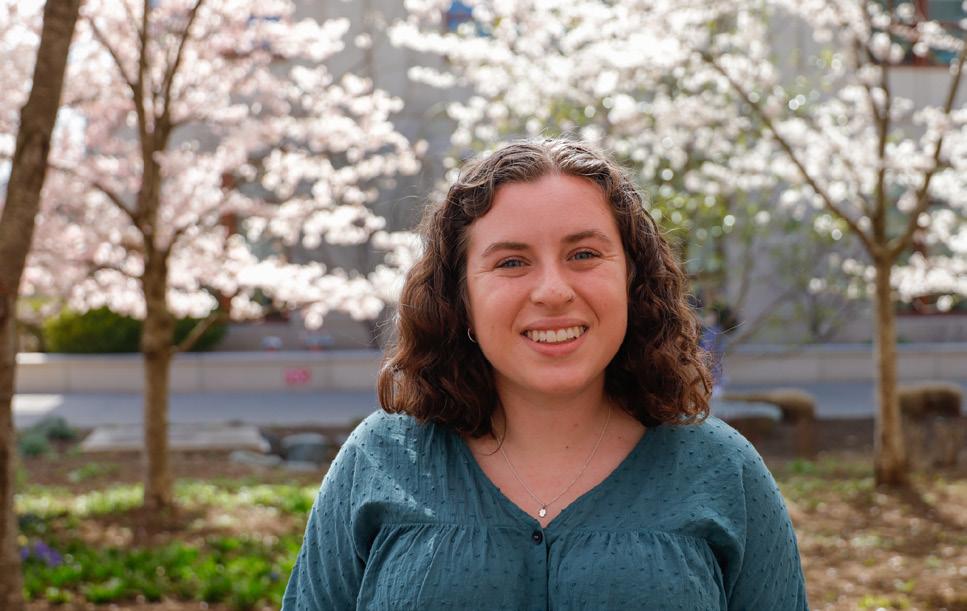
AU community come together in times of joy and tragedy and hope and despair and every time find myself in awe that I got to play a part in chronicling its history.
The community at The Eagle is special and rare and something that is hard to find. One of my favorite parts of The Eagle is that like clockwork, new staff members arrive and learn from people only a few years older than them, if at all, eventually becoming the people they once admired so much.
When people ask me about college, the first thing I typically talk about is The Eagle. I may be graduating with a degree in journalism, but it often feels like my real major has been The Eagle.
This job was every bit as challenging and demanding as former editors-in-chief warned me it would be, if not more. It’s also been incredibly fulfilling. On a campus where it's easy to feel alone, The Eagle gave me something to be proud of. I’ve demanded so much of this paper because I believe so strongly in it as a tool to do good — even when the going gets tough.
Being the editor-in-chief of a college newspaper is an unusual job, and I don’t think I was prepared for how lonely it would feel at times. I was 20-21 years old and making decisions that had an impact on the people and community around me, often in ways I’m still trying to wrap my head around.
When the pandemic upended my freshman year and moved my entire sophomore year online, The Eagle became my main source of connection to the AU community. Students at AU care about making a difference in our community, and I’ve loved getting to tell their stories, no matter how big or small. I’ve seen the
The Eagle’s role on campus has never been more important, and there is so much to be proud of. We covered the Staff Union’s strike, published an investigation into the failures of AU’s Office of Equity and Title IX, honed in on multimedia content and continued to uplift underrepresented communities in our coverage, to name a few. We won awards, grew our social media presence and held ourselves accountable where we made mistakes. But the things I am most proud of you can’t quantify in numbers. I can’t count the hours I’ve spent in our MGC 252 office or afternoons I’ve had derailed when news breaks, but I can tell you I can’t imagine spending my time doing anything else this year. Knowing I could play a small part in making The Eagle better is something I’ll always be grateful for.
Knowing there are people who are willing to do the work to make it better shows how special this place is, and there’s a few I’d like to thank.
Thank you to Eliza Schloss and Carly Johnson, who were some of my first Eagle friends and people I knew I could always count on. Thank you to Abbie Veitch, Kelsey Carolan, Brianna Crummy, Sophie Austin and Lydia Calitri, who all believed in me long before I did. To Sarah Mattalian and Koz, who kept me afloat, both personally and professionally this year. Thank you to Clare Mulroy and Skye Witley, who were always there to listen and find ways to laugh even amidst chaos. I’m thankful for all of the brilliant managing editors I worked with this year, who worked tirelessly to improve their sections. Another thank
you goes to Taraji Ellington, Rebecca Oss and Izzy Fantini who brought their passion for the online and multimedia sections together. I’m also lucky to have people to lean on and learn from like Fariha Rahman, Abby Turner, Sophia Solano, Jordan Young and Abigail Pritchard, to name a few. Thank you to Amy Eisman, John Watson and the rest of the School of Communication faculty for being some of The Eagle’s biggest advocates and allies. I feel so lucky to have learned from journalism’s best these past few years.
None of this would have happened without Clare Mulroy, who convinced me to apply for editor-in-chief despite my initial reluctance. I’m also thankful for all of the alumni who gave me support and advice this year, including Heather Mongilio, Zach Cohen, Brett Zongker and the rest of the Eagle Advisory Board.
Thank you to my non-Eagle friends. Knowing your opinion of me was never based on what you thought of The Eagle mattered more than you realize.
I know The Eagle has a bright future ahead of it. There will always be ups and downs, and I’m excited to see what the next generation of Eagle staff does to meet them. I am excited for the vision and passion Abigail Pritchard will bring to the table, ready to meet the challenges and find her voice as a leader.
Many students call AU home, but there’s a little room on the second floor of MGC that felt like home to me much more than other corners of this university ever did. It’s bittersweet to say goodbye, but it’s a little easier knowing I get to carry with me some of the things The Eagle gave me.
Nina Heller Editor-in-Chief 2022-2023 nheller@theeagleonline.com
3 theEAGLE April 2023
COVER PHOTO: IZZY FANTINI / THE EAGLE
MADDIE MILLER / THE EAGLE
AU ANC commissioners bring student voices to DC politics
by Abigail Hatting Local News Reporter
For Diego Carney, a freshman in the School of Public Affairs, his start in politics was through campaign work in high school. Sophomore in the College of Arts and Sciences Rohin Ghosh’s political engagement also began in high school through local community organizing in his California hometown. Now, at 19 years old, the two of them are some of D.C.’s youngest elected officials as the Advisory Neighborhood Commissioners for American University’s campus.
What are ANCs?
In the district, ANC commissioners represent a part of their neighborhood in nonpartisan, unpaid elected positions. Established in 1976, three years after Congress granted D.C. home rule, they are the voice of the neighborhood to the local government and serve twoyear terms.
While ANCs don’t have legislative power, they can present resolutions on issues such as zoning and liquor licenses, and they work closely with other elected officials who do have the power to pass laws. AU is part of district 3E, which includes Tenleytown and Friendship Heights.
As the elected commissioners for AU’s two on-campus districts, Carney, representing district 3E07, and Ghosh, representing 3E08, advocate for students on neighborhood issues.
Diego Carney
Carney was born in Panama and lived there until eighth grade when he moved to the D.C. area. He attended high school in Bethesda, Maryland. As a CLEG major, he also works as the director of communications for the D.C. chapter of Voters of Tomorrow.
After deciding to run for ANC as a write-in candidate at the beginning of this school year, Carney ended up in a tiebreaker with fellow freshman Micah Rogers. Per D.C.’s drawing of lots law, a coin flip ended with
Carney as the victor on Dec. 12. ANC 3E hosts Zoom meetings on the second Thursday of every month at 7:30 p.m. There, eight commissioners discuss neighborhood issues and propose solutions. The main issues Carney is focusing on in his term are affordable housing and bike lanes, which are especially pertinent for college students.
Carney said the reactions he has received from the community have been overwhelmingly positive, especially considering the highly political environment of AU.
“My mom thinks it’s the coolest thing in the world,” Carney said. “I love my mom. She thinks I’m like the president of Tenleytown. I had to tell her no.”
Carney said that he tries to appreciate every opportunity to learn and encourages others to do the same.
“I’m young. I’m still a college student. But I do feel like I can at least try to make an impact in the community.”
Rohin Ghosh
Ghosh, an American Studies major in the College of Arts and Sciences, started out doing local tenant organizing in his hometown of Palo Alto, California. When he started at AU in 2021 as a Community-Based Research Scholar, he continued volunteering. Since Sept. 2022, he has worked as an eviction defense canvasser and tenant organizer for the Latino Economic Development Center. Through this work, Ghosh said he was able to better understand the depth of the housing crisis and how it intersects with other issues such as racial inequity.
When Ghosh learned of the opportunity to run for ANC, he got help from AU alumnus Christian Damiana, who held the seat before he did.
The main issues that Ghosh is focusing on are workers’ rights, tenants' rights and combating police violence.
“The lack of good, quality, affordable housing options around campus is “not only exclusionary to Black
and brown Washingtonians [who] are locked out of here, it also contributes to housing problems for students,” Ghosh said.
One thing that the ANC has direct power over is guiding development and zoning processes. Ghosh said that the neighborhoods in and around AU have the potential to be more dense by adding more affordable housing. Additionally, Ghosh wants to repurpose road space to safely accommodate cyclists and pedestrians and improve transit access, since many students don’t drive.
Ghosh said that the biggest challenge in this role for him so far has been time management as a full-time student and an elected official.
“ANCs are often not given the type of weight that they should be … their role is not given the resources it needs,” Ghosh said. “That is especially true for young ANCs, especially true for ANCs of color … and for women ANCs.”
A lot of the time, community members view student issues as separate from district issues at large, according to Ghosh.
“We are still residents of the district just as much as anyone else who lives here is, and have needs and effects on the district just as everyone else does,” Ghosh said.
Ghosh’s long term goal is “working on building a network of progressive, left-minded ANCs across the district so that we have a really strong coalition across all eight wards to push on issues that affect students, working people, tenants [and] transit riders.”
Carney and Ghosh are regular collaborators and often find themselves with similar things to say at ANC meetings. Ghosh says he considers them to be partners in their work.
According to Ghosh, the ANCs are a “real need and unique opportunity that we have as students to actually have a seat at the table of local government.”
ahatting@theeagleonline.com
With small numbers, AU STEM students find community
by Zoë Bell Community Engagement Editor
Ariane Raymond spends her weekends in the Hall of Science, surrounded by dry-erase markers and walls of handwritten chemistry problems. Some weekends involve 18 hours of studying.
Raymond, a junior studying chemistry and biochemistry on a pre-med track, said she has always wanted to be a doctor. She was drawn to American University with the Hall of Science and opportunities in the nation’s capital.
“I really wanted to be in D.C., and in high school, I got really involved in activism and politics and really fell in love with that sort of stuff and wanted to be somewhere close to that,” Raymond said. “I always still wanted to be pre-med, always wanted to be involved in medicine.”
The Hall of Science, constructed in 2020, is home to AU’s biology, environmental science, chemistry and neuroscience departments.
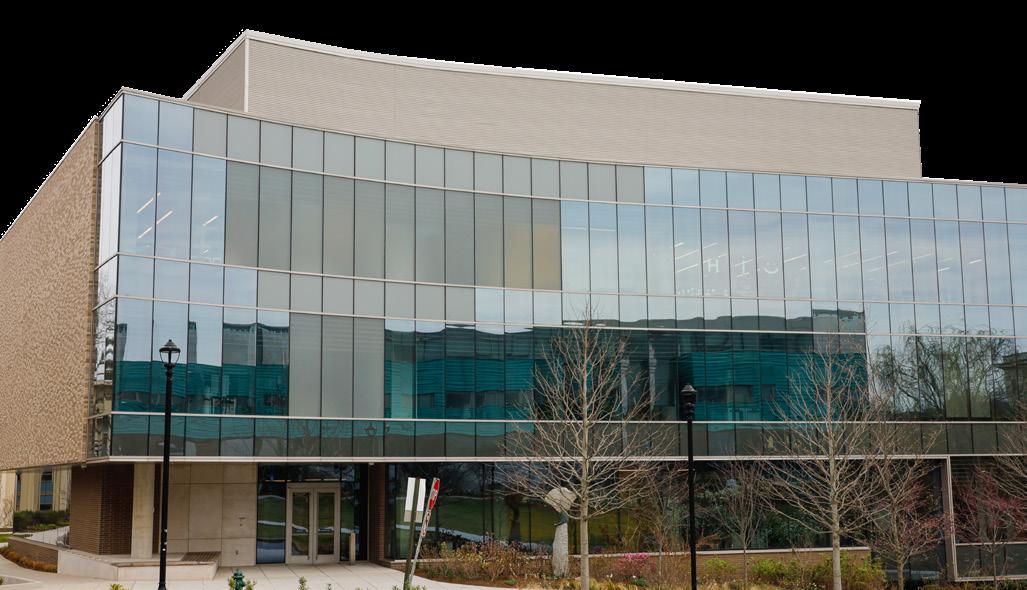
Zachary Cutler, a sophomore biochemistry ma he toured other
schools prior to AU and was unimpressed by some schools’ secondhand lab equipment. The Hall of Science, however, caught his eye.
“It’s brand new, all the equipment is great. It sparkles. You go in and you’re like, ‘I’m in the future,’” Cutler said.
Although data from the 2021-22 Academic Data Reference Book shows STEM majors make up less than 16 percent of AU’s undergraduate population, the University’s website says science is the fastest-growing area of undergraduate study.
Cutler said he is glad to be part of a close-knit community at AU, especially since STEM students are in the minority.
“As much as it would be nice to have more STEM students, everyone knows who you are and everyone talks to each other,” Cutler said “… Everyone knows who everyone is in their field, which is nice.”
Raymond, who initially thought she would be talked over in what she thought would be mainly male-dominated classes, said she feels represented.
“Most of my classes are women,” Raymond said. “… There’s also a pretty large queer community within the STEM department and so I always really enjoy that.”
Some STEM students, however, say finding community at AU is not as easy. Being known as one of the nation’s most politically active college campuses, being in less common majors comes with its own set of challenges. Collin Coil, a junior studying mathematics and data science, said he considered transferring schools for this reason.
“I would caution other students who want to come to AU as a STEM student,” Coil said. “You would be in the minority; you would mostly be ignored. It is not
good for any student to come to AU who is not political science, international studies or something we’re well known for.”
Coil is a member of AU’s chapters of American Statistical Association and the Association for Computing Machinery, neither of which is currently active, he said. Coil is involved in three research teams, studying gender in congressional witness panels, international macro finance and generative artificial intelligence.
“I find that most of my research opportunities have to be outside of [the College of Arts and Sciences] and are actually in government or finance departments,” Coil said.
A member of the CAS dean’s advisory council, Coil said he proposes changes to the council that the University administration can make to better represent STEM students, such as increased funding for undergraduate STEM research.
“I’ve also been engaged with other University [leaders] who have discussed ambitions to become more of a STEM school,” Coil said. “I think that these ambitions are more planned instead of being in the process at the moment, but I think that AU has an increasing focus on becoming a STEM school.”
Maggie Seidel, a junior chemistry major, tabled for AU’s Preview Day on Feb. 20 in hopes of being able to share her experiences with prospective students.
“I wish I would have talked to somebody in my shoes when I came to one of those events to actually hear from the student how it is …” Seidel said. “And it would’ve been so nice to know that [professors are] so accessible here and they’re truly rooting for you.”
IZZY FANTINI / THE EAGLE
4 theEAGLE April 2023 NEWS
zbell@theeagleonline.com MADDIE MILLER / THE EAGLE
by Isabella Brown and Tyler Davis News Staff Reporters
American University is considered one of the most politically active college campuses in the country, according to a study by The Princeton Review. However, some students feel that political activism on campus overlooks underprivileged and marginalized voices.
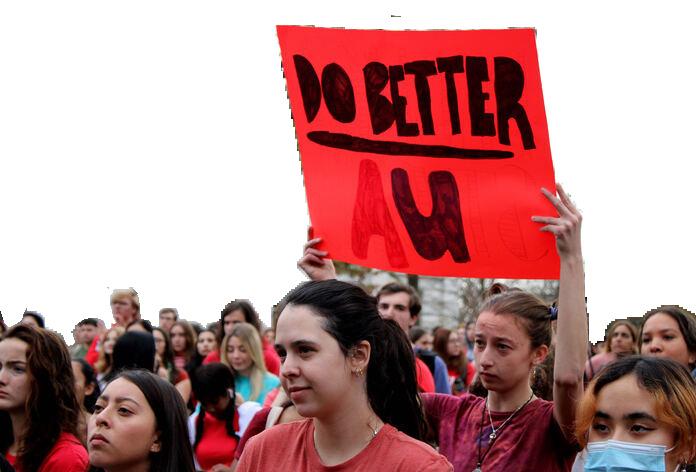
Many say that the perspectives of students of color, faith-based communities and immigrants can be excluded and overshadowed by groups with more privilege.
“Personally, I've seen that a lot of the time it's the majority group speaking for minority groups,” said Alina Hasan, a sophomore in the College of Arts and Sciences and a member of the Muslim Student Association’s advocacy team.
When it comes to intersectional issues, some students say that the University’s response falls short or does not appear at all. Representatives from both the Asian American Student Union and Korean Student Association participated in a vigil held to honor victims of the Monterey Park and Half Moon Bay shootings.
“I think one thing we drew from it is that from the AU administration, we don’t get that much support,” Lilla Khan, a sophomore in the School of International Service and the vice president of AASU, said. “To this day, I think [the] AU administration was still very silent about the fact that these shootings happened and it was pretty overlooked.”
The University sent an email to students from the affected areas in California following the shootings, but did not send out a University-wide announcement.
“It was just basically silence,” Adrienne Yeh, a senior in SIS and the co-president of KSA, said. “It’s kind of like they handpick certain instances they want to highlight.”
The Muslim Student Association is another organization that actively participates in social activism on and off campus. The organization recently raised approximately $4,000 for victims of the earthquakes in Turkey and Syria. Members also protested the treatment and genocide of Uyghur Muslims in China on Capitol Hill.
“I have a lot of interest in understanding the differences even within the Muslim community, across sex, across races, across ethnicities, across immigration,” Taha Vahanvaty, a freshman in the School of Public Affairs and a discussion facilitator for MSA, said. “Spearheading and focusing on dialogue across those lines of difference within the Muslim community is something that I hope on incorporating within the larger discussion circles.”
Vahanvaty said he feels that immigrant and faithbased communities are often excluded in discussions around diversity, equity and inclusion and overlooked
Student organizations highlight a lack of intersectionality in campus activism
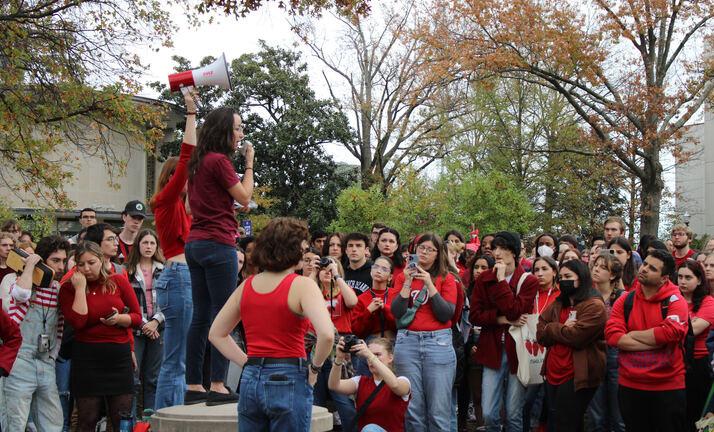
in political activism on campus. International students make up 10.8 percent of the student body, according to the 2022-23 Academic Data Reference Book.
“I think the venn diagram of [diversity, equity and inclusion] and activism very closely overlaps, but oftentimes it's thought of in terms of gender or race or socioeconomic status,” Vahanvaty said. “And faith has kind of been one of those things that you keep at home. Like you practice what you believe, you can do whatever you want, but you do that in your own room.”
Vahanvaty added that first-generation immigrant students who come from more conservative communities can be excluded in political activism on a campus known for its liberal reputation.
Some students said they feel minority students’ experiences and voices are often co-opted by more privileged groups on campus. Hasan said she experiences this in the classroom when non-Muslim students try to speak on behalf of Muslim women in Iran. She gave the Black Lives Matter movement as another example.
“We would want that affluent group to stand with those groups of people rather than standing up for them and speaking for them because you can't really speak on a struggle until you've actually experienced it yourself,” Hasan said.
John Paul Mejia, a sophomore in CAS and the campaign manager for the AU Sunrise Movement’s Green New Deal, said he feels that political movements on campus can be susceptible to whitewashing.
“When we don't articulate demands in social movements and say explicitly what we want and who we're targeting, we leave a conversation open to those who often make decisions and those who often are closer to power to co-opt what that conversation may be and therefore also claim what victory is,” Mejia said.
Vahanvaty said although some students from marginalized communities are excluded in activism, he thinks AU students are aware that they need to include more student voices from different backgrounds. How ever, Vahanvaty said he feels “jaded” by student activ ism.
“The activism I've seen on campus has a lot of in tentionality, but I personally don't see a lot of impact,” Vahanvaty said.
Some students say that despite the University's high ranking when it comes to political activity, the activism on campus feels performative, with the words often not translating into actions.
“I think there’s also a sort of big cul AU that … [kind of] beperfor mative, where people say that they’re interested in progressive causes, but then aren’t actually doing anything to advance those causes,” Pine said.
Many students said
they feel similarly and said the University administration has not done enough in response to recent protests. Mejia cited the staff and graduate student union strike in fall 2022 as an outlier and praised the movement’s organizational and strategic skills.
“What I fear of other forms of activism or movements on campus is that they can be easily defanged by meaningless structures or working groups that can be provided for the administration, which may not offer enough accountability for that to be a victory that the movement can claim,” Mejia said.
According to Hasan, activism on campus only goes so far and the University itself needs to prioritize having a diversity of voices in order to effectively respond to students.
“Protesting helps, but people that are within the administration should also be working to bring about change,” Hasan said. “I feel like if you want diverse voices to be heard, you need to put those diverse voices in power, and I feel like we don't see a lot of that on campus.”
Given AU’s politically active reputation, students find themselves dismayed about what they feel is a lack of tangible movement from the student body when it comes to activism and advocacy.
“I think at AU we might think of it as people are really politically involved, but I always ask, like, what does that mean?” Eli Pine, a senior in CAS and vice president of the Claudia Jones Club, said. “What politics are they involved in? Is it just an internship on the Hill or are they getting out into the community and doing real power-building?”
ibrown@theeagleonline.com
tdavis@theeagleonline.com
5 theEAGLE April 2023
Although some student organizations make an effort to include a diversity of voices, many still feel that political activism on campus overlooks marginalized groups
IZZY FANTINI / THE EAGLE
IZZY FANTINI / THE EAGLE
Students took to the quad on Nov. 10 to protest the University's handling of sexual violence on campus
When it comes to faculty diversity, students and faculty say AU has more work to do
by Mariana Trujillo and Katie Mass
Veronica Botero arrived at American University with high expectations for faculty diversity. Going to a predominantly white high school where the only Hispanic faculty taught Spanish, she hoped to have a new experience at AU.
Botero, a freshman in the School of Public Affairs and the freshmen liaison for Latinos En Acción, hoped to find a Hispanic law professor that she could look up to as a positive role model, to show that her career aspirations were possible. Based on the information she received during her admissions tour and in emails from the University, Botero entered AU with expectations for representation that haven’t been met yet.
“I really have limited options when it comes to me, because as much as I might connect to a white professor, there's no deeper connection than being able to relate to an ethnicity,” Botero said.
Some students said they feel that despite being labeled the most liberal college in the country, AU falls short of student expectations and needs in terms of faculty diversity.
Both students of color and white students noticed differences in faculty diversity based on what school their major fell under. A student in the Kogod School of
Business, of which 32 percent of full time faculty identified as persons of color, has a higher chance of having a full-time professor of color compared to a student in the School of Communication, which has nearly half as many full-time faculty of color at 15 percent, according to an analysis by The Eagle of data from the 20212022 Academic Data Reference Book.
While some have noticed progress, students and faculty both said that there is still work to be done. Since 2017, the percentage of full-time nonwhite faculty has increased by a little over two percent, according to the Reference Book, which includes Middle Eastern as white.
Discrepancies in faculty diversity
Daniel Punales, a sophomore in the College of Arts and Sciences and SPA and a first-generation college student, said he has noticed different levels of faculty diversity based on the department his classes are associated with. SPA has 15 percent more white full-time faculty than CAS, according to the Reference Book.
“I've had different interactions with different departments. So it's not equal across the board, but like, some are better than others, like I say,” Punales said.
Similarly, Isabella Macchia, a sophomore in the School of International Service, said she thinks she has had an almost
equal number of white and nonwhite professors but believes this is because of her major, which requires her to take language courses. According to the Reference Book, SIS had the third highest percentage of white full-time faculty at 77.17 percent in 2022.
“I definitely think it's an SIS thing,” Macchia said. “And I take Japanese, and so my Japanese professor both semesters freshman year was a Japanese woman, which I feel like is also important because you need to understand like that cultural complexity as well.”
ever, she said that her peers not majoring in education also care about how they’re learning and who they’re learning from.
Saeed said that terms used by the University like “inclusive excellence” feel like buzzwords for marketing rather than actual efforts to prioritize diversity. When it comes to diversity and representation, Saeed says there still isn’t enough progress.
“We’re more than a business transaction,” Saeed said.
Data from the Academic Data Reference Book shows that SPA has the highest percentage of white full-time faculty at 86.49 percent, whereas the School of Education has the lowest percentage at 65.38 percent. There was no data provided on part-time faculty.
Qudsia Saeed, a junior in the School of Education, noticed more diversity in the professors she has in SOE than in other schools she has taken classes in. How-
Administering ‘Inclusive Excellence’ and diversifying hiring
The AU Plan for Inclusive Excellence works to increase inclusivity and improve the campus climate. It began as a result of the 2017 Campus Climate Survey, which revealed significant differences in the campus experiences of people of color compared to white people.
Inclusive Excellence is a framework developed by the Association of American Colleges and Universities in 2005. The University is currently in Phase Two of the plan, which focuses on advancing racial equity. According to Jasmine Pelaez, AU’s internal communication manager, President Sylvia Burwell introduced the AU Plan for Inclusive Excellence in 2018 “to address issues of inequality on our campus and build a culture of inclusion, in collaboration with university leadership, staff, and faculty members.”
LaTanya Sothern, the new president of the AU Alumni Association, graduated in 1992 from SOC and CAS. She said the Plan for Inclusive Excellence is embedded in everything the Alumni Board does.
Sothern praised President Sylvia Burwell as the most accessible president of AU so far to alumni.
“President Sylvia Burwell, since the day she has arrived, has done nothing but demonstrate her dedication and commitment not to just talking about inclusivity but also really turning the knob from you know, her executive council all the way through to making sure that inclusivity and inclusive excellence was a part of what
6 theEAGLE April 2023
As AU measures ‘Inclusive Excellence’ progress, students find representation falls short in the classroom
Collegeof Arts&Sciences 71% KogodSchoolofBusiness Schoolof International Service Schoolof Communications SchoolofEducation 67% 77% 85% 86% 65% Percentag e of white facult y by school CARLY JOHNSON / THE EAGLE
We often talk about the front of the classroom needing to look like the back of the classroom.
-Kelli Frias
we do,” Sothern said.
According to Pelaez, the hiring process at AU begins with the establishment of a search committee, which is required to schedule a diversity, equity and inclusion workshop with the dean of faculty. The open faculty position is posted on job boards and networks and the selected faculty member is onboarded with an orientation. The University is currently in the final stages of developing AU’s first guide to inclusive hiring.
Kelli Frias, an assistant professor of marketing in Kogod and faculty representative on the board for the Latino & Hispanic Faculty and Staff Affinity Group, began working at AU in 2019. She has participated in numerous hiring committees and discussions on strategic planning.
“We often talk about the front of the classroom needing to look like the back of the classroom,” Frias said.
The marketing department within Kogod uses The PhD Project, an organization working to increase workplace diversity by increasing the number of diverse faculty in business schools, to recruit new faculty. Frias said she participated in the program as a doctoral student and was probably the 13th “Hispanic or Hispanic female” faculty member in the country in marketing when she exited the program.
“I would like others to know that there's opportunities and there's a place for you and that it's needed, much needed,” Frias said. “And I think it benefits what we talk about, what we teach, and the student experience.”
Ying-Chen Peng, an assistant professor in the Department of Art, said that diver-
sity, equity and inclusion is a very important factor in CAS in hiring new staff and faculty.
“When we talk about whether this person is a good fit to our program, or our department, we definitely put the cultural heritage and adapters and scholarship into account,” Peng said.
Peng is also a co-chair of the newlyapproved Asian American, Native Hawaiian and Pacific Islander Faculty and Staff Affinity Group. The group was created in response to AU’s vocal and ongoing commitment to diversity and inclusiveness, according to Anna Fung, an assistant professor in Kogod’s Department of Management, who is also a co-chair of the affinity group. One of their goals is to provide a platform to faculty to share resources to better serve the AU community and AAPI students, Fung said.
“Some faculty members actually help bring out the voices that used to be overlooked. And their presence itself would definitely greatly encourage student participation and engagement,” Peng said. “So I think, at AU, the faculty diversity is definitely a big issue that we're working very hard on making improvement.”
Selene Malench, a sophomore in SIS and CAS and the alumni relations director for the Asian American Student Union, believes that faculty diversity is still not made a priority, but also feels that AU has made more of an effort in recent years.
“I feel like that has really shone through with the new hires that we get and the different deans of different schools. But that being said, AU is still a predominantly white institution. So they have made prog-
PERCENT whit e students
ress. I think they still have a lot of work to do,” Malench said.
her outgoing personality helped her find a community and people to relate to, but she said that process could be more difficult for students who are shy.
“But for the most part, I think it's been mainly on the students, especially minority students, to find their own niche, their own group, that they can relate to,” Botero said.
Students find importance in classroom representation
According to an assessment of the 2017 Campus Climate Survey, “students reported that it was important to see themselves reflected in the faculty and curriculum to create a sense of belonging and inclusiveness.”
After almost two years at AU, Oni Chaytor, co-president of Sister Sister, said this semester is the first time she’s had a Black female professor. The SOC sophomore said as an aspiring journalist, it is especially impactful having a Black professor in her journalism classes. Chaytor noticed that her white professors typically only brought in white guest speakers, which made it difficult for her to visualize herself working in a predominately white industry.
Sense of belonging
The University is measuring the Plan’s progress by looking for improvements in the Campus Climate Survey data. According to the measuring progress section of the Plan for Inclusive Excellence, in the Campus Climate Survey results for 2023, AU hopes to have “at least 70 percent of students, faculty, and staff feel[ing] that AU is committed to creating a campus where everyone has a sense of belonging,” which would be a 12 percent increase from undergraduate students and an 11 percent increase from faculty in 2019.
AU is a predominately white institution, with the undergraduate student population, both full and part time, consisting of just over 55 percent white students, according to data from the 2021 to 2022 Academic Data Reference Book. Many students of color said that they found community in student organizations and affinity groups.
Sofia Guerra Oropeza, a junior in CAS, is from Mexico City and is the vice president of the Mexican Club at AU. As an international student and a transfer student, she struggled to transition to U.S. schooling and felt more supported by students than by the administration.
“I do feel a sense of belonging, but it took time,” Guerra Oropeza said. “When I first transferred here, it was a very lonely process.”
Botero found belonging in student affinity groups and felt that AU did not help foster her sense of community. She believes
“It kind of discourages me from, like, asking for help in terms of, like, looking for opportunities, because I feel like they just wouldn’t really understand the type of, like, opportunities and internships I'm looking for as a Black woman,” Chaytor said.
During the t, AU hired approximately 100 new full-time faculty members, 70 percent of whom self-identified as persons of color, according to Pelaez.
“As we continue to increase faculty diversity, we are also focused on retaining talented and diverse faculty members,” Pelaez said in an email, referencing a $1 million ADVANCE grant from the National Science Foundation to help AU retain faculty in underrepresented communities in STEM.
Botero has so far been disappointed by the reality at AU. Wanting to see someone like her at the front of the classroom was something she thought would happen at AU.
“A school like AU, which is notoriously known to be the most liberal school in the United States, should have a higher faculty diversity,” Botero said. “And it's not about being exclusionary to white people who are also qualified. It's about letting your students of color also be able to have mentors who are experts in their field, because the experts are there, we just need to look for them — we need to do a better job of hiring them.”
7 theEAGLE April 2023
investigations@theeagleonline.com
70 of 100 new full-time facult y member s identi fy as per sons of color
55
(par t time & full time unde rgra duat e population )
CARLY JOHNSON / THE EAGLE
AU is still a predominantly white institution. So they have made progress. I think they still have a lot of work to do.
-Selene Malench
*
*data from 2022-2023 academic year
American University’s acceptance rate nearly doubles for the Class of 2025 A deeper look at AU’s admissions
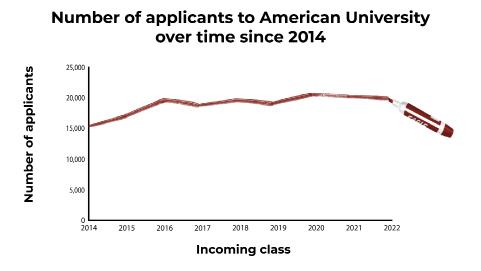 by Kathryn Squyres News Staff Reporter
by Kathryn Squyres News Staff Reporter
Google “American University” and the results might look a little different compared to previous years. After averaging a 32 percent acceptance rate for the last five years, AU’s acceptance rate doubled to 64 percent for the Class of 2025.
AU’s acceptance rate ranged from 26 percent to 39 percent in the past five years, according to data from the University’s Academic Data Reference Books. The acceptance rate varies based on the number of applicants and the changing enrollment targets set by the administration, according to Andrea Felder, the interim vice president of undergraduate enrollment.
AU’s acceptance rate over the years
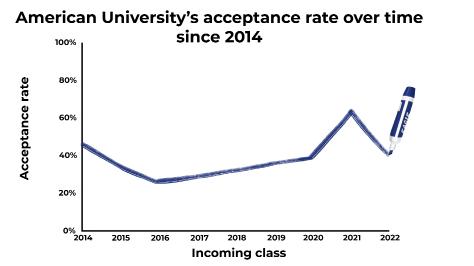
It’s natural for acceptance rates to vary from year to year, according to Jasmine Pelaez, the internal communications manager for the University. AU’s number of applicants increased before steadying for the past several years while the admit rate fluctuated, according to data in AU’s Academic Data Reference Books and the National Center for Educational Statistics.
Most notably, the acceptance rate jumped to 64 per-
cent for the incoming class in 2021 from 39 percent the year before.
The Class of 2025 and its acceptance rate
AU doesn’t aim for a specific admit rate each year, University officials said. Rather, it creates enrollment targets — the number of students it aims to enroll, according to Felder. These targets vary each year.
The University enrolled a smaller number of students in fall 2020 for the Class of 2024 because of the coronavirus pandemic and made a “strategic decision to enroll a larger class in 2021, of which we had a strong pool of applicants,” according to a statement given to The Eagle by the Office of University Communications and Marketing.
Compared to prior years, AU received a similar number of applicants for fall 2021 but accepted a larger number of those applications. This meant the percentage of students accepted increased significantly, leading to an acceptance rate of 64 percent.
Though the University intentionally admitted a larger class, more students enrolled than the University should have allowed under its 2021 Campus Plan, a 10-year agreement with D.C.
The plan states that AU must provide housing for 67 percent of full-time undergraduate students. Based on
AU’s housing capacity, this limits the number of full-time undergraduates the University can enroll.
In fall 2021 and fall 2022, AU enrolled more students than the plan allows. The University had to notify Advisory Neighborhood Commissions 3D and 3E and work to “mitigate any impact” of a higher enrollment and “implement policies” that ensure that AU can reach compliance again in the coming semesters, according to Elizabeth Deal, the assistant vice president for community & internal communication.
“The goal is to create a cooperative environment that supports the quality of life for both our neighbors and our students,” Deal said.
Looking deeper at enrollment targets
Several offices — including the Office of Enrollment, the Office of Institutional Research, the Budget Office, the Study Abroad Office and Chief Financial Officer — work together to establish enrollment targets at the beginning of each two-year budget cycle, according to Felder. Matthew Bennett, the vice president and chief communications officer at AU, noted that these can be adjusted between budget cycles to account for annual changes.
When calculating the size of an incoming class, the University must consider the number of returning students, the number of students studying abroad and the number of students graduating early, among other factors, said Bennett.
Once the University has an idea of how many students it can enroll, it selects students who are a good fit for AU, said Felder. She added that the admissions office relies on historical data models to understand how many students are needed to reach the enrollment target.
The number of applicants compared to the number of spots open for an incoming class determines the acceptance rate.
Shaping the incoming class
Felder said that the University is always looking to increase its reach nationally and globally when recruiting new students.
“We're always aiming to try to cast a wide net of students in terms of the number of applications we receive,” Felder said. “That's helpful because it does allow for additional diversity within the class and thinking about big umbrella diversity. So race, ethnicity, geography, socioeconomic diversity, international and global diversity as well, different majors.”
AU uses a holistic approach to admissions, meaning that students are evaluated based on their overall application rather than individual pieces like test scores.
The University looks at students’ grade trends throughout high school, community engagement, essays, teacher recommendations and demonstrated interest. AU “first and foremost” values students’ academics and grade trends throughout high school, Felder said.
“[We’re] looking for bits and pieces of the application that will tell us that the student will come to the University, be successful in their classes, that they'll thrive in the campus community, that they'll get involved in and want to engage with other students and their peers as well,” said Felder.
Felder said she doesn’t believe the acceptance rate will impact prospective students’ views of the school.
“We don't typically, when we're recruiting, lead with admit rates at all with students and families,” said Felder. “We lead more so with the AU story, telling stories about students and their experiences and how students can come to our campus and thrive in the community. So it does not impact us in our work.”
8 theEAGLE April 2023
ksquyres@theeagleonline.com CARLY JOHNSON / THE EAGLE
‘Myrna on Main Street’ web series aims to increase engagement in local businesses
by Ellie White News Staff Reporter
When a local music shop needed to create a video describing their business for a grant program, they tapped Tenleytown resident and owner of Middle C Music Myrna Sislen to narrate it.
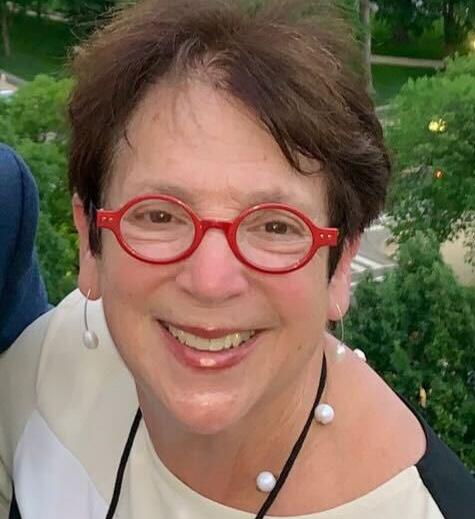
According to Sislen, presenting the video felt very comfortable, especially the humorous aspects. After filming the video, Sislen decided to look at other submissions for the program.
“I looked at a local one, a cheese shop on Capitol Hill,” Sislen said. “The owner of the cheese shop never showed you a piece of cheese. And I thought this is really quite something, where's the cheese in this cheese shop?”
Seeing the cheese shop’s video after helping to create a different one gave Sislen the idea for the “Myrna on Main Street” video series. With the goal of helping out independent Tenleytown businesses that may be struggling after the pandemic, Sislen creates humorous and informative videos business owners can use on their own social media platforms.
The “Myrna on Main Street” video series is a part of Tenleytown Main Street, a nonprofit organization that works with local residents and businesses to create a “business district that is a thriving, walkable, and friendly neighborhood center,” according to its website.
According to Kyle Todd, the executive director of Tenleytown Main Street, the organization works directly with owners to provide “business health checks.” Checks
may include cosmetic improvements, additional hiring or giving businesses need-based grants from the program.
Since the creation of the “Myrna on Main Street” video series, Sislen has created a variety of different videos, including wearing flippers and a divers mask to promote a diving shop, making pizza for a pizza restaurant or doing yoga against a wall for a yoga studio.
“The good part of this is, I am old,” Sislen said. “So I will do basically anything. If I get embarrassed, I don't care, it's all something that will work for the business.”
After filming each video, Sislen sends a flash drive of the video that the business can use in their own promotion at no cost.
Todd said currently, D.C. businesses are in what is known as the “recovery mode” after the coronavirus lockdowns.
“Businesses are still hurting,” Todd said. “Our goal right now is to not only do corridor-wide promotional events to get visitors into the neighborhoods, but to work with businesses for some very targeted promotional activities, just for those businesses.”
One promotional event that Tenleytown Main Street has introduced for the spring semester is Tenleytown Tuesdays, where businesses give discounts to anyone with an educational ID, including AU staff, faculty and students.
According to Sislen, people have come up to her on the street and recognized her from the video series.
“People … say that they’ve seen them, that they love
the episode, … lots of people have gone, ‘Well, wait a minute, American Valet, I didn't know that you could get your shoes fixed there,’” Sislen said. “... So it’s the awareness, and people are watching them. And hopefully, it’s helping the businesses. How the business uses it, on their own, is really up to them. And hopefully they are using it.”
ewhite@theeagleonline.com
AU’s Model UN team reflects on rise to fame and what the future holds
“A lot of credit goes to the head delegate, Lizzie Williamson, who is now our CEO of the International Relations Society at AU,” Qureshi said. “I learned a lot from her on how to do this and what it takes and all the work that it entails.”
Qureshi said that the conversation about “what it takes” is a common discussion in the team.
COURTESY OF ZAMAAN QURESHI
by Samantha Skolnick News Staff Reporter
This year, the University of Georgia had their football team, Kansas had their basketball team and American University had their Model United Nations team after reclaiming their spot at #1 on April 2. Ranked No. 1 in North America, AU Model UN has won the most awards of any team in the 2021-2022 competitive collegiate circuit.
Previously, the AU MUN team rose from the 75th spot in North America in 2013 to sitting in its current spot at the top, according to the AU International Relations Society’s website. Being ranked the best in the continent in the 2021-2022 year is the highest that the team has ever been, and it is the first competitive season that it
has reached this high mark.
Recently, the AU MUN team traveled to Montreal, Canada to McGill University for their first conference of the spring semester. At the McGill conference, AU came out “with the most amount of raw points and gavels,” according to the team’s Instagram. The team also recently competed at the Harvard University conference, finishing with five “Outstanding Delegate” awards, an “Outstanding Delegation” award and five “Honorable Mentions.”
Last year, Zamaan Qureshi, a junior in the School of International Service and the School of Public Affairs, helped the Model UN team reach its highest-ever ranking while working as assistant head delegate. Now the head delegate, Qureshi said the team owes a lot to the leadership from last year.
“It’s definitely a lot of imposter syndrome around competing on this team,” Qureshi said. “There’s a huge amount of prestige on Model UN simply because of the amount of investment universities put into their teams.”
Being in the University’s “call to fame” team comes with pressure that the members of Model UN deal with daily. Similar to any sports team, Qureshi said keeping a steady life is sometimes difficult.
“In that vein, as a college student who is trying to balance school and everything as well, it kind of feels like a lot,” Qureshi said. “But I think that the approach that we’ve taken is to remain true to our values and that’s something that always hit home over and over and over again with our team that ‘What made us get here is what’s going to keep us here.’”
Additionally, in order to keep the team in high standings, AMIRS hosts an annual high school Model UN conference called AmeriMUNC to raise money and share the lessons of Model UN, a weekend when high schoolers can be seen roaming AU’s campus in heels and dress shoes.
Nick Valbuena, a senior in SIS and the College of Arts and Sciences and the secretary-general of AmeriMUNC, joined Model UN his freshman year. Valbuena explained how AmeriMUNC is the business branch of AU Model UN and a key to the competitive team’s success. This conference invites a thousand high schoolers from across the world to AU’s campus, said Valbuena. By hosting this conference, the fees from the visiting students go towards funding AU’s competitive Model UN team to cover the price of traveling to and participating in competitions, which can have heavy costs. He said that the team’s success comes with many advantages.
“It has brought greater credibility to what Model UN is on campus,” Valbuena said. “Understanding that we are above Georgetown, we’re above all these Ivy League schools, has an allure to it.”
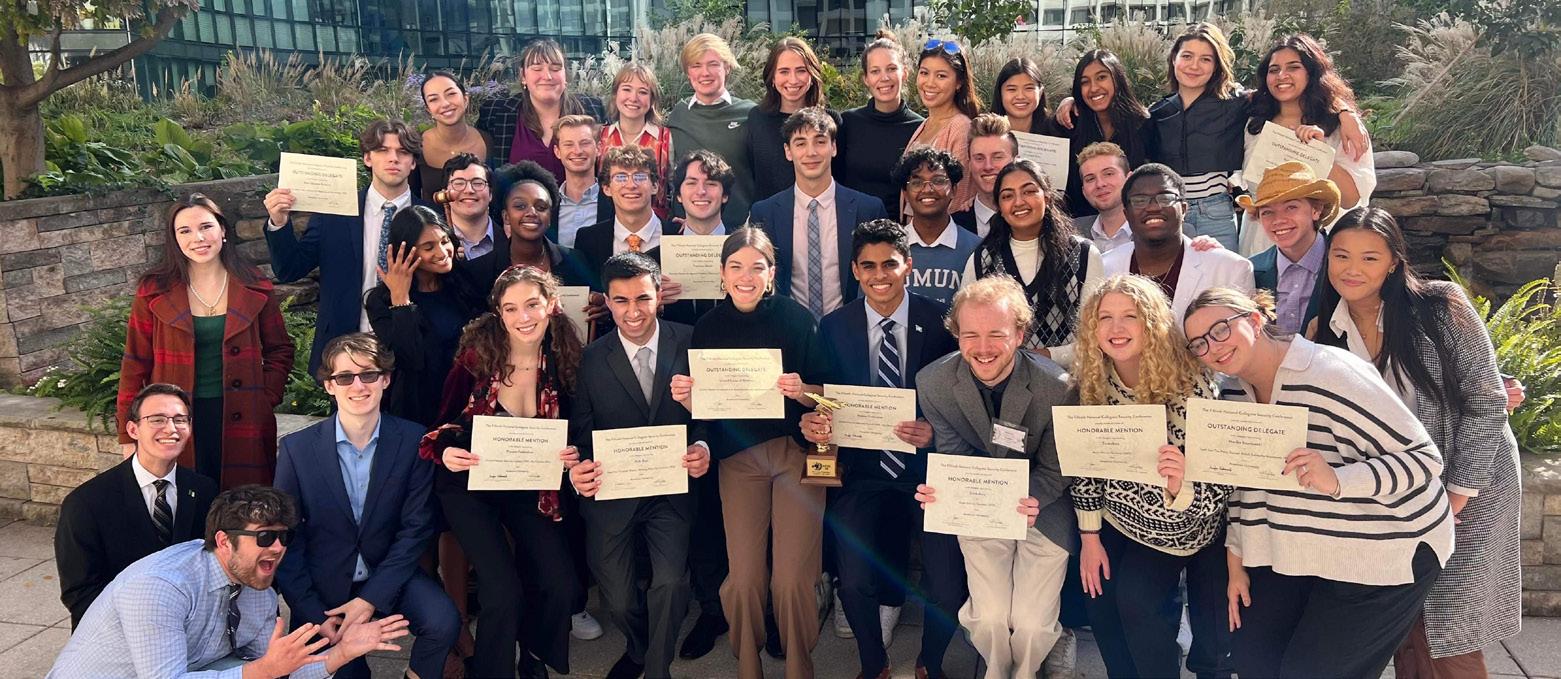
In the future, the team will go on to other conferences while working hard and training weekly. The team is still waiting to find out how they stand midway through the season. Qureshi said they are keeping their fingers crossed that they keep their number one ranking and come out on top again.
“It’s really incredible that this competition has created so much competition and so much community at the same time, it’s pretty amazing,” Qureshi said.
9 theEAGLE April 2023
PHOTO COURTESY OF MYRNA SISLEN
sskolnick@theeagleonline.com
Sunrise AU proposes Green New Deal to increase transparency with sustainability efforts
by Jenna Schwartz Life Staff Writer
Back in January, the American University Sunrise Movement chapter announced its initiative to build a “Green New Deal” for AU. Over the course of the semester, flyers for the AU Green New Deal have been taped up all around campus, with Sunrise members interviewing students on their opinions.
As the proposition stands now, it includes a mission to completely decarbonize University operations, ensure food security for students and faculty, fair wages for campus employees and add environmental justice education to core curriculum classes among other agendas.
AU was the nation’s first carbon neutral university, but Sunrise AU’s proposal of a Green New Deal hopes to push AU’s sustainability practices further. One of the ideas they are pushing is that being carbon neutral is not enough.
“Instead of reaching zero carbon, they think they can stop at this carbon neutrality point because they have carbon offsets,” AU Sunrise member and Student Government Senator Sal Cottone, a sophomore in the School of Public Affairs, said. “Students come to the campus thinking that everything is renewable energy, and that we're already at zero carbon, because some students just aren't aware of what carbon neutrality actually means.”
Carbon neutrality entails removing the same amount of carbon emissions that are being released as opposed to having no carbon emissions at all. Usually, this means that carbon offsets or credits must be purchased by the institution that is carbon neutral.
Half of AU’s energy comes from solar power located in solar farms in North Carolina, and 2,500 solar panels on campus that produce roughly 1 percent of the campus’ energy. The solar farms are located in the northeastern part of North Carolina, which is on the same power grid as D.C. The rest of the University’s energy comes from renewable energy credits, serving as offsets of AU’s carbon emissions, according to the Office of Sustainability.
“We have received feedback from the student body that there's not a general understanding of how this university operates,” Maddie Young, a junior in the College of Arts and Sciences and one of the core draft writers of the AU Green New Deal, said regarding carbon neutrality on campus.
“The Office of Sustainability does transparently report [emissions], but then University marketing is really where there's that disconnect between what they're transparently reporting and what most people actually see and then come to understand based on that,” Young said.
Despite this, the Office of Sustainability knows that carbon neutrality is only one step towards a more sustainable future at AU.
“In 2021, we released a new sustainability plan,” Megan Litke, AU’s director of sustainability, said. “It was definitely a recognition that carbon neutrality was an important milestone, but it's just a milestone on our sustain-
ability journey.”
Although students from Sunrise AU have been in talks with the Office of Sustainability about their shared goals for reducing emissions, students still plan to cover more ground.
“It's not just about being classified as an arboretum or having the ability to call ourselves carbon neutral,” Sunrise AU member John Paul Mejia, a sophomore in the College of Arts and Sciences, said. “It's ultimately about also how students are doing on this campus and how staff are doing on this campus.”
Last semester began with many AU staff members going on strike in an attempt to improve their wages and labor agreement, with many first-year students walking out of convocation in solidarity.
Sunrise AU has always been focused on fair wages as a part of their agenda, but for Mejia and others, the strike certainly solidified a need for it to be addressed in policy.
“The process of being able to stop the climate crisis or abate it means that we put in as much priority to the environment around us as we do to people,” Mejia said. “I think that economic justice for workers or for students, is a core part of that.”
This approach to climate justice is recognized as a
larger part of the Green New Deal at the national level and especially with the Sunrise Movement nationally.
The Sunrise Movement at the national level holds the congressional resolution, the Green New Deal as a tenant of its core mission. Originally introduced by Sen. Edward Markey (D-MA) and Rep. Alexandria OcasioCortez (D-NY), the draft climate resolution lays out goals about achieving net-zero greenhouse emissions, creating fair wage jobs, guaranteeing clean air and water, and prioritizing infrastructure.
For the national Sunrise Movement, applying the Green New Deal locally is a step in the right direction in order to adopt a national resolution, its members say.
“I think that change like a ‘Green New Deal’: it comes from the bottom up,” Magnolia Mead, a junior in the School of Public Affairs and Sunrise AU president, said. “If we can win a Green New Deal on our campus, that not only sets the stage for other institutions, other schools around the country to do the same thing [...] we need to utilize our strategic place in the nation's capital to push for that kind of change.”
The Green New Deal for AU is not a completely solidified proposal, as Sunrise AU is continuously seeking more input from students, staff and professors.
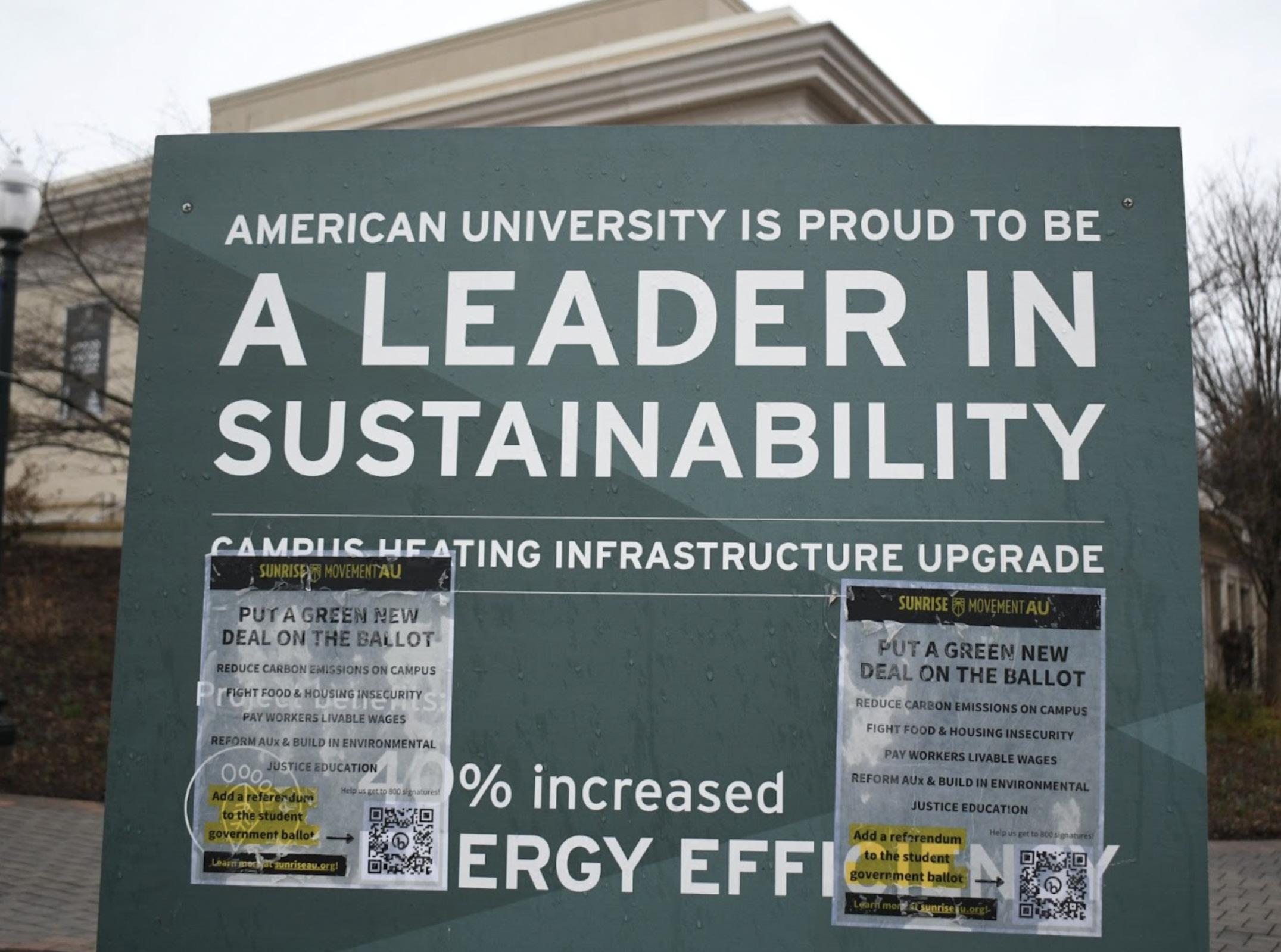
“We understand that a vision this large is hard to achieve.” Mejia said. “We also know that achieving a vision this large will not be possible without critical support from the student body and leverage that we built.”
jschwartz@theeagleonline.com
10 theEAGLE April 2023 LIFE
JENNA SCHWARTZ / THE EAGLE
It's ultimately about also how students are doing on this campus and how staff are doing on this campus.
- John Paul Mejia
From campus decarbonization to fair wages for University staff, AU activists demand more from the administration
Music Library creates community for music students
Used by students and professors, the library is for more than checking out music scores
by Maria Tedesco and Sydney Hsu Life Staff Reporters
Easy to miss, but vital to the success of the music program at American University, the Music Library is tucked behind the main staircase in Katzen. Unknown to most students at AU, according to faculty and student library workers, the Music Library brings music to the AU community in preparation for auditions and personal use.
Mary Gottlieb, a staff collaborative pianist at AU, goes to the Music Library daily as she helps students with lessons and auditions.
“[The librarians] are willing to jump in and help with the computer, and help find things. Because I’m usually in the middle of rehearsals with kids when we suddenly want something, they’re willing to help find it fast or bring it to me,” Gottlieb said.
According to the library’s website, the collection features music collections ranging from audio and video databases, over 12,000 scores and music sheets, over 10,000 CD collections and film collections and DVDs. A unique aspect of how the Music Library displays its collection is how musicians of color are highlighted. This effort is made possible by the Collection Amplifying Diverse Voices and

supports students as they seek out musically diverse scores. CADIVO has its own section that is immediately visible upon walking into the Music Library.
“I feel like music from minorities are kind of just like buried, and it's kind of hard to find, if you go through our library, most of it's probably going to be dead white men,” Tiana Taylor, a junior in the College of Arts and Sciences who works at the Music Library, said. “So at least we're just putting it all in one place.”
Last semester, Calla LaBeau, a senior in the College of Arts and Sciences, used the library to find a score by Emma Lou Diemer. LaBeau then performed the piece in an AU Chamber Singers’ concert.
“We knew that we needed pieces by specific, specific artists and so we looked in the library and we were able to find that piece and then learn it and perform it for the concert,” LaBeau said.
Outside of AU-affiliated music groups and classes, non-music students can come to the library with friends and check out its features as well. Those wanting to learn how to play the guitar or piano, for a band or just for fun, can check out the music without having to pay, according to Taylor. The Music Library even has a ukulele that can be used by anyone wanting to learn.
Besides resources, the Music Library also provides a space for music students
SYDNEY AFFOLTER / THE EAGLE
to congregate. Attached to the library’s main section, there’s a computer lab that doubles as a place for music students to come together.
“It’s just a nice place to study or a chill space to exist,” LaBeau said. “And I like spending time in there to just decompress in between classes.”
Additionally, the Music Library hosts performances called “Soundbites” to highlight work being done by student groups or in classes. Musicians, such as the student cast of “Cabaret,” fill the Katzen Rotunda with music on select Tuesday and Thursday afternoons in between classes.
The Music Library gives space for students and faculty to explore what music AU has to offer. Giving patrons diverse and recent music, the Music Library has helped to cultivate an inclusive environment fit for anyone interested in learning more about music.
“People are in and out of [the Music Library] all the time,” Gottlieb said. “It’s a friendly place. They have music playing. It’s nice to have just a little bit of a music spot.”
shsu@theeagleonline.com
mtedesco@theeagleonline.com
SOC’s IDEAS Institute uses science fiction technology to complement filmmaking
by Samantha Myers Life Staff Reporter
“Help me Obi-Wan Kenobi, you’re my only hope,” is Princess Leia’s infamous plea in “Star Wars: A New Hope.” During this scene, Princess Leia is communicating as a hologram, something that seemed dystopian when the film was first released in 1977. Now, this technology isn’t so far-fetched.
The Institute for Immersive Designs, Experiences, Applications and Stories, is a research studio in the School of Communication where students, faculty and local residents can utilize 360-degree hologram technology.
The IDEAS Institute was brought to American University in March 2022 by Krzysztof Pietroszek, an associate film professor in SOC. Through a $1 million dollar governmental MRI grant, the technology was purchased from a company called YOOM, named TetaVi at the time of purchase.
Thirty-six motion capture cameras work together to record a person or animal within a circle in the center of the room, at 360 degrees. From there, the video gets rendered and sent to eight different computers that generate a hologram of the recording.
“You can use them in AR, VR, even in 360[-degree] videos, even normal videos,” Becky Lake, a graduate student in
SOC and the volumetric capture specialist for the Institute, said. “For golf, for example, you can see the pose of someone who's putting. You can see precisely at what angle or move around to see the different angles, even above. So you can help model your body,” Lake said.
The IDEAS Institute is the only place in D.C. with this kind of technology, according to Lake. While outside partners can come in to collaborate with it, such as doctors from George Washington University, this resource allows students to try their hands at unique projects across various fields ranging from theater to education.
“I am only one person, so I have ideas of how this can be used, students might have different ideas. So even ideas of things that can be done would also be wonderful as well,” Lake said.
Holographic capture can be used to render any type of movement. Some past projects have involved dance showcases, educational demonstrations and video game avatar creation.
Besides coming in with projects of their own, students can also get involved behind the scenes. Ian Whitehouse, a junior in the College of Arts and Sciences, started working on a robot after being reached out to by Pietroszek.
“It's definitely very cool getting to work with this brand new technology,” Whitehouse said.
All majors across AU are welcome, with the most frequent visitors being in the game design, computer science and film and media arts programs, Lake explained. Film and media arts majors find the IDEAS Institute as an innovative way to perceive movies.
“One of [professor Pietroszek]’s actor friends came down from New York City to film an interactive play where he gives lines of dialogue and you play the other character,” Whitehouse said about a project called “Vera” that he helped film.
Students are also encouraged to use this resource to pursue their own creative endeavors outside of the classroom. With such a rare technology available, the IDEAS Institute presents a unique opportunity to explore the world of augmented reality and the future of creative pursuits.
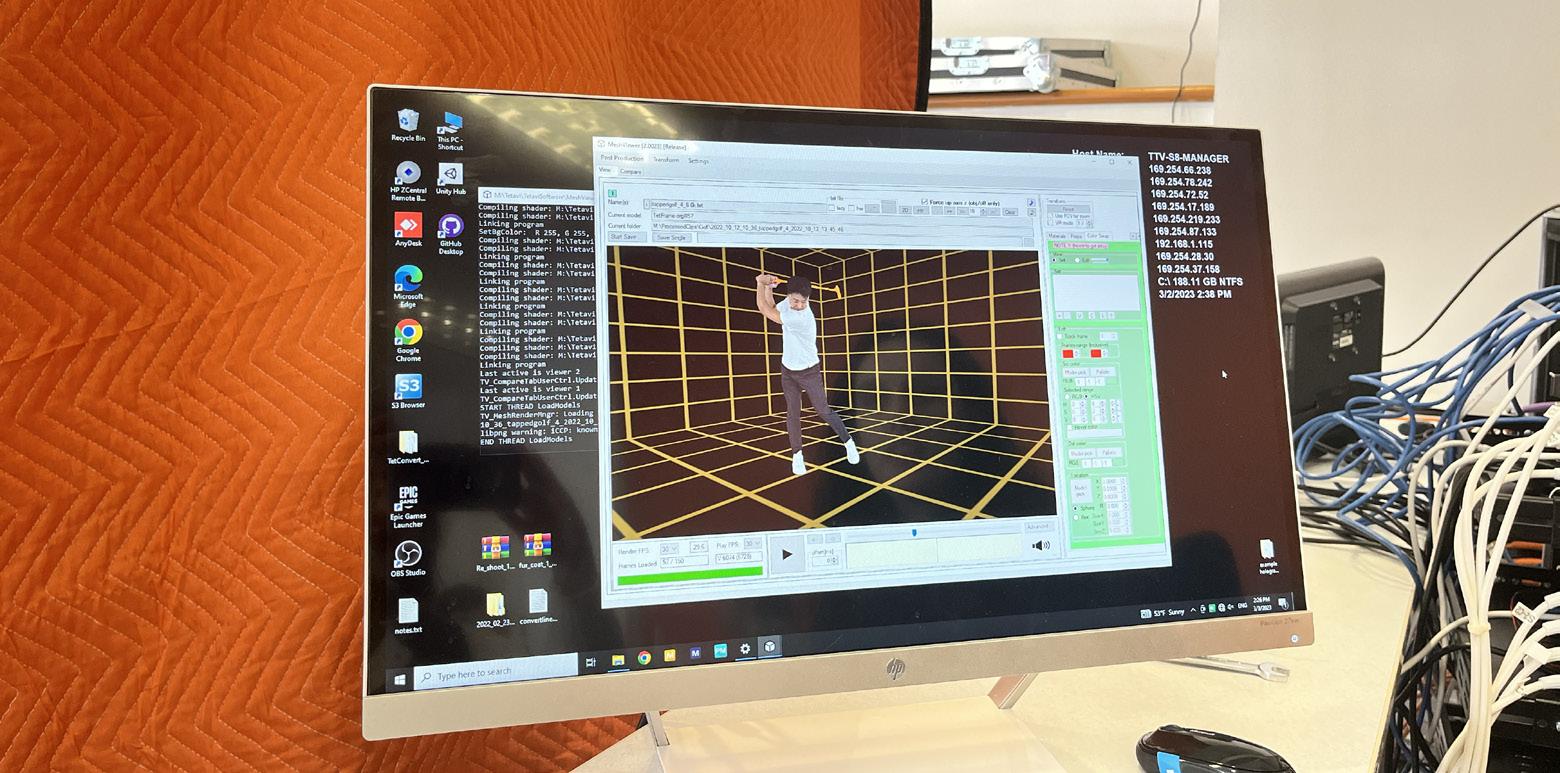
The IDEAS Institute is especially great for film and theater. With a 360-degree perspective, actors in film can be seen at all angles by the viewer when placing a hologram in the room they’re in. Acting can now be done with smaller casts, and characters can interact with the viewer.
“It changes how you think about directing your actors in what they do,” Lake said. samanthamyers@theeagleonline.com
11 theEAGLE April 2023
SAMANTHA MYERS / THE EAGLE
AU students create the Edible Campus Initiative to deepen knowledge about plants on campus
The project includes an interactive map where students can find various plant species on campus
by Marina Zaczkiewicz Life Staff Reporter
There are over 400 different types of edible plants on American University’s campus. With the help of the AU Edible Campus Initiative and its resources, students can discover which edible plants grow on campus and which are usable to cook with.
Created by students Ashley Hocking, Kat Raiano and Emily Bass, the initiative provides information on specific plants around AU’s campus that can be used for edible or medicinal purposes, as well as an interactive map so students can learn where to forage for different plants.
The initiative informs community members about plant species on campus and increases food sovereignty, as well as teaches students the importance of accessibility to healthy and sustainable food.
You can find intricately designed graphics on the group’s Instagram which describe the differences between edible and medicinal plants. The website, which includes the interactive map, outlines best harvesting practices such as taking only what you need.
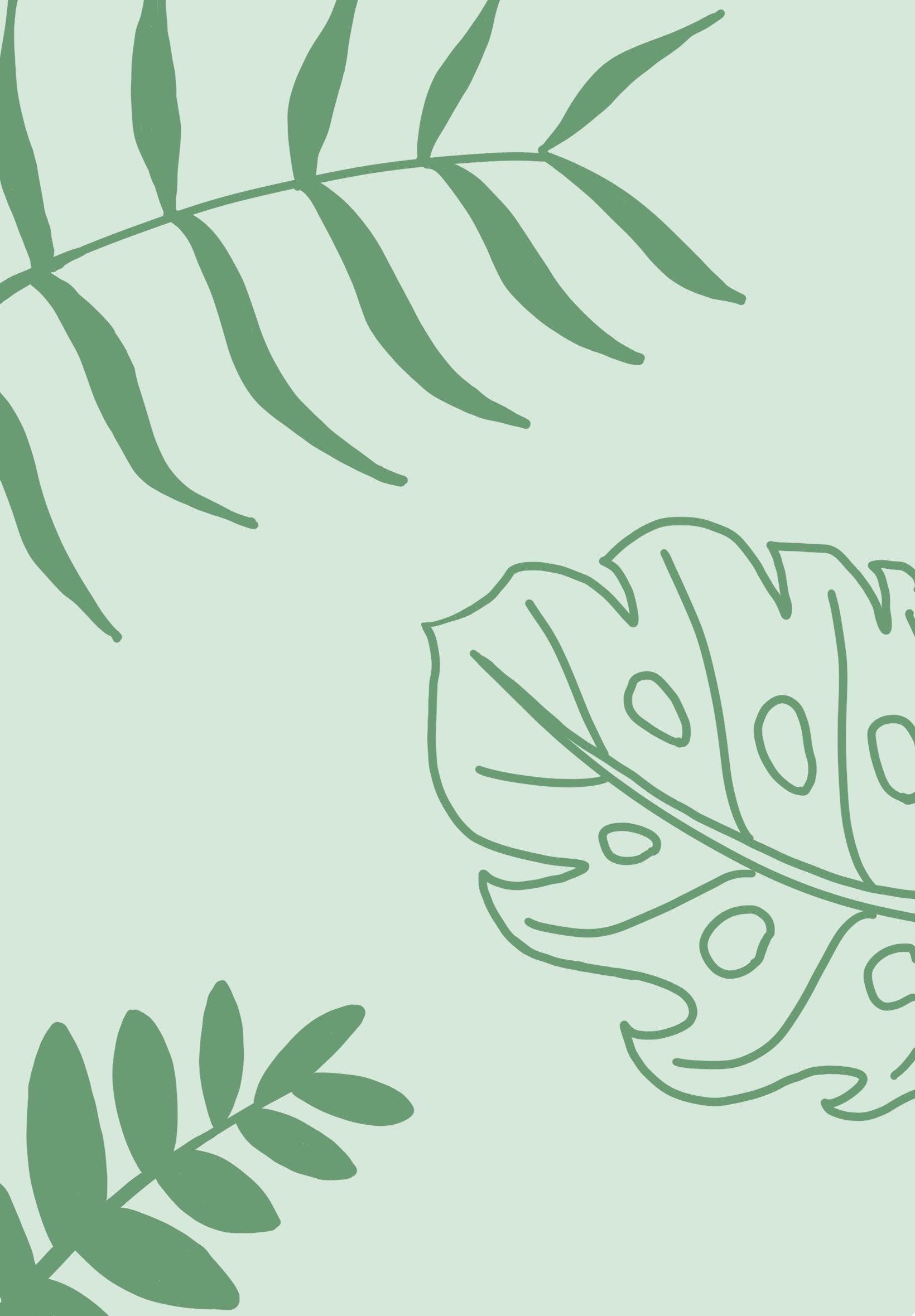
Hocking, a junior in the College of Arts and Sciences, explained that the creators shared social media posts with each other about foraging and got excited about it, wanting to take it a step further to expand their plant knowledge.
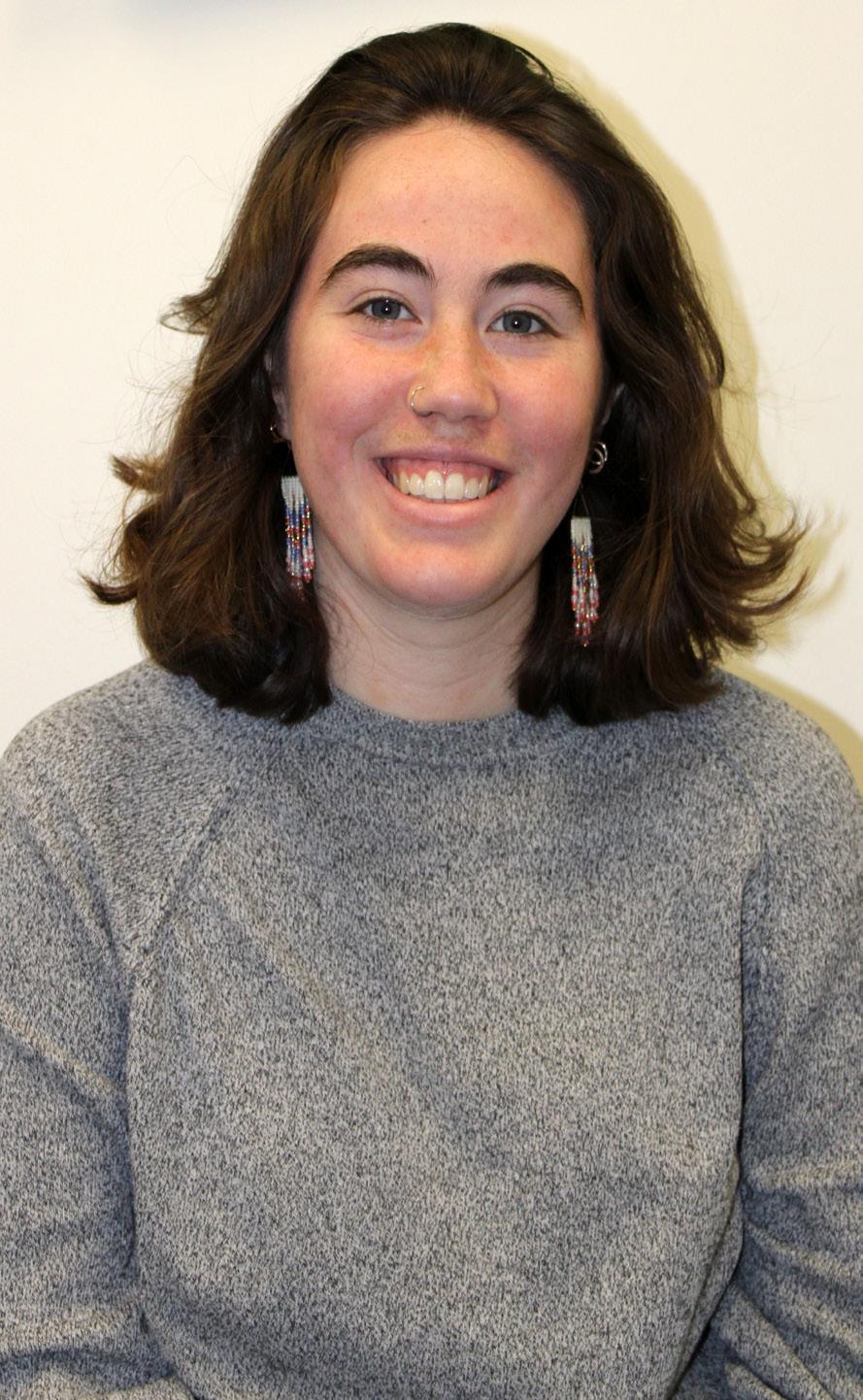
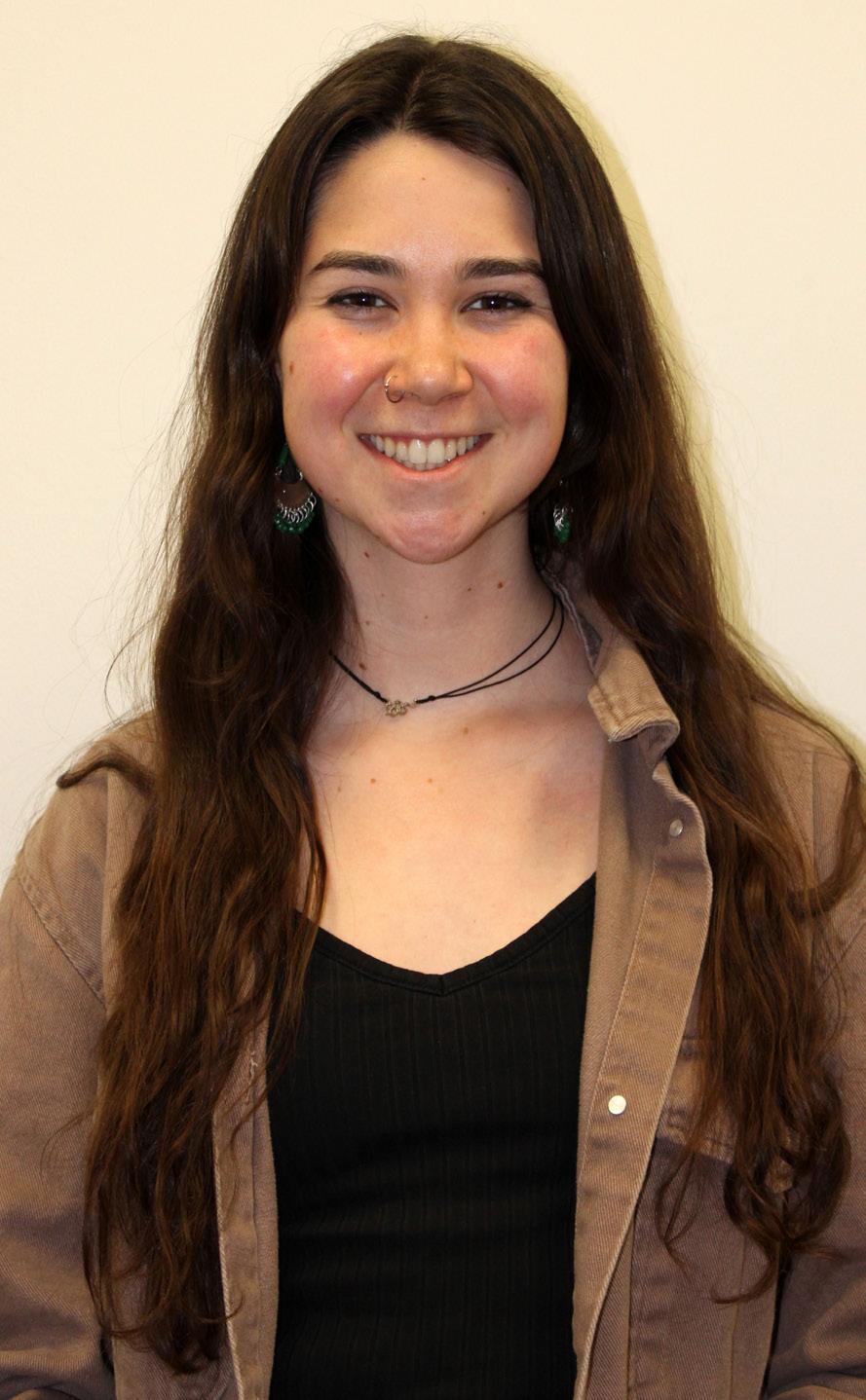
Hocking said that “there is such a disconnect with people and the land, especially because there is this
rhetoric that we’re not a part of nature.” The initiative can better bridge the gap between people and the land by teaching them what it can offer and how to take advantage of that responsibly, Hocking said.
“Something I learned at the Community Garden is people want to pick food, but not everyone is sure what these vegetables are [and] what you can do with them,” which is why having interactive resources and activities is important, Hocking said.
Raiano, a junior in CAS, said the practice of foraging “encourages a better relationship with the land because otherwise, foraging is just like another way of consumption if you aren’t really thinking about what it is you're taking” and the ecosystem you are impacting.
The disconnect between humans and nature “destroys knowledge that should have been passed down and used to be passed down on how to live off of [the land,]” Hocking said. This initiative was an attempt for Hocking and her peers to reconnect with lost knowledge.
This project provides an incentive to get outside, explore and get creative with recipes such as beautyberry jelly, made of American beautyberry, a species critical to over 40 bird species. These recipes are important because students are “able to incorporate the actual uses of those [plants,]” Raiano said.
“If you're foraging for it, you’re almost sort of playing by the rules that the landscape has set out,” Raiano said. “Some of them may not be native, but some of them offer a really unique opportunity to engage with that plant in a respectful way.”
Students can explore their imaginative side because “the creativity flows naturally in nature because nature is creative,” Hocking said. Those using these resources can modify recipes to suit their own needs as long as they are being sure to correctly identify plants they’re consuming.
Utilizing the initiative’s resources to discover the uses of various plants informs students about the land they are interacting with on a daily basis, and the recipes could be a fun activity to do with a group of friends. Raiano encouraged other students to explore safely on their own, because the project is not finished yet, there is still more to explore.
Investigating what the campus has to offer is a great way to relax from the stressors of studying. The project allows people the opportunity to “gather knowledge in a way that we aren’t necessarily really taught to in a traditional academic setting,” Raiano said.
“You are working with the plant to create something new that is beneficial for you and for the space where you got it from,” Raiano said.
mzaczkiewicz@theeagleonline.com
 – Kat Raiano
– Kat Raiano
12
You are working with the plant to create something new that is beneficial for you and for the space where you got it from.
theEAGLE April 2023
THE EAGLE
Ashley Hocking (left) and Kat Raiano (right), two of the creators of the Edible Campus Initiative
PHOTOS AND GRAPHICS BY IZZY FANTINI /
Members of AU’s art department want more program opportunities for growth and community building
by Marina Zaczkiewicz Life Staff Reporter
Located in the nation’s capital, American University is most commonly known for its political science and international studies programs. But students in AU’s Department of Art have found an outlet to express their creativity. Providing students with the opportunity to engage in a strong arts program can help them have an outlet to express creativity, but without necessary funding and opportunities, it can be hard to develop a robust program.
Students and faculty say that they want to increase opportunities and resources with help from AU to further develop the program. The department offers majors in art history, graphic design, photography and studio art for undergraduate and graduate students. In fall 2022, there were 81 bachelor’s students whose primary major was located in the Department of Art, while there were 1,544 bachelor’s students whose primary major was international studies.
Logan Forbis, a senior in the College of Arts and Sciences and the School of Communication, said that she loves how small the community is in the Department of Art but wishes the program had more funding than it does now.
“I definitely feel more supported by my professors, as opposed to the University as a whole,” Forbis said about program funding. “There are some things that you simply cannot do without certain materials, as opposed to some subjects, where access to textbooks can be solved through the library and access to other materials can be more easily given by a campus.”
Andrea Pearson, the chair of the Department of Art and a professor of art history, emphasized the importance of funding. Funding and space “are things that are give and take, push and pull all the time on campus,” she said.
“There are people who have donated to the art department so we have donors, most of the time those are scholarships,” Pearson said. “We have some of those. We always wish we had more.”
Jasmine Pelaez, AU’s internal communications manager, told The Eagle in an email, that “AU’s 2-year budget process is transparent and provides multiple opportunities for participation and input from our students, faculty, and staff. The University Budget Committee collects information on priorities and requirements from all campus constituencies through various forms of outreach. Each school, including the College of Arts and Sciences, gathers budget requests submitted by its individual departments to help inform the budget process. This process allows us to achieve multi-year operational efficiency.”
Naoko Wowsugi, an associate professor in the Department of Art, explained the importance of making sure students have access to materials and events to showcase their work. She said student artists should be encouraged to connect to the D.C. art scene and discover what is beyond AU.
Despite these hurdles in a smaller department, students manage to bring passion and creativity into their work.
Wowsugi said community building and highlighting students begins in the classroom. She emphasized the art program as a growing department
at AU and that the aim should be to create a more inclusive community through art by providing students with a path that diverges from a typical academic one. When doing art, “you learn about yourself, what you prefer, what you like. And that, finding who you are, create[s] appreciation for others to be who they are,” Wowsugi said.
Julia Lane, a freshman in the College of Arts and Sciences, described the professors in the Department of Art as personable.
“I find that all of the teachers that I’ve had so far are incredibly passionate about what they teach,” Lane said.
In the busy atmosphere of AU, it is important to have an art, work and life balance, Wowsugi said. Wowsugi stressed the importance of promoting the benefits of being an art major as well as the need to have new conversations and course offerings. When students get academically overloaded, it can be difficult to tap into their creative sides, she said.
“Even students who aren’t majoring in art may get internships based on skills they have picked up in classes such as video editing,” Wowsugi said.
Double majoring can be a great way to find inspiration, Wowsugi said. When students are able to manage their time, double majoring can provide another outlet for students to be creative and forge connections between various interests. With a more interdisciplinary approach, students can incorporate their academic studies into the creation of art, Wowsugi explained.
Forbis, who has majors in journalism and graphic design, said there can be a stigma around majoring in something art related but the need for digital design is helping graphic design get a better reputation as a major.
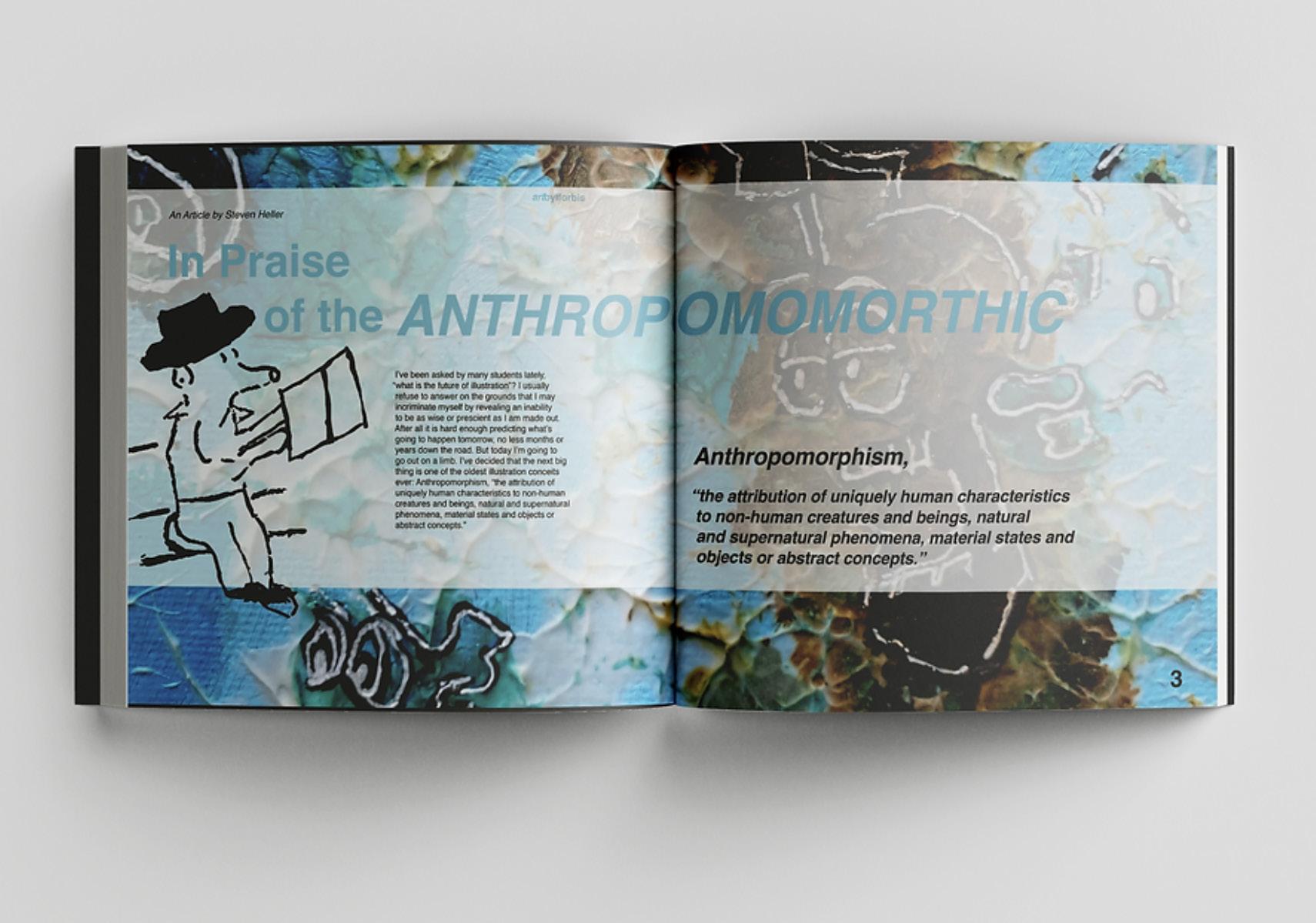
“I would say that most of the majors we have don’t come in knowing that they’re going to major in what we offer," Pearson said. For those who don’t necessarily want to create art or work in a museum, “there are
opportunities in grant writing and nonprofits.”
Some students may feel hesitant to study art because they aren’t aware of all of the possibilities that being an art major can provide.
“Presenting to people what you could do with an art history major could potentially create an environment where students feel more comfortable about considering it as an option,” Lane said. Lane suggested making sure first year advisors are more knowledgeable about AU’s art majors, so students interested in double majoring can have more tailored first-year advising experience. “It’s pretty discouraging that the bigger majors have things like major specific job fairs and career support that are not a thing or lacking in the arts program in my experience,” Lane said.
For those in the arts at AU, they say it sometimes is hard to find ways to get other students to see the department in the same light they do when they may not have as much exposure to it. But learning how to make connections between the arts and other interests is important, students say.
“We understand how our discipline connects to other kinds of ways of exploring the world that students might be interested in,” Pearson said. These interests include gender, religion or geography, she said.
Despite being small, students in the Department of Art say they feel inspired to discover and develop their passions.
“Leaning into the community that is so special in AU is something that I wish I had done a lot sooner,” Forbis said.
mzaczkiewicz@theeagleonline.com
13
COURTESY OF LOGAN FORBIS
theEAGLE April 2023
Work by Logan Forbis, a senior in the College of Arts and Sciences and the School of Communication
Q&A with runner Row Sullivan
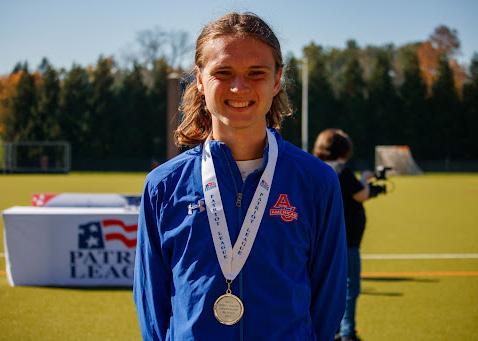
Q: Through four years of running at AU, what do you feel was your biggest takeaway?
A: I think my biggest takeaway is just “value teammates while you’re here.” Ultimately, that’s the best part of being on a team in a D-I sport is the friends you make along the way. I’ve met some of my hopefully best lifelong friends here, so that’s definitely what I’ll remember years from now.
Q: What was the most challenging part of your four-year career here?
by Marco Gacina Sports Staff Reporter
Row Sullivan is a tough-as-nails senior on the cross country team. On top of the rigors of multi-disciplinary running, Sullivan has also dealt with the adversity that comes with being one of the nation’s first openly nonbinary Division I athletes. They opened up about their running career at American University thus far, their gender identity in sports and where they see the conversation headed in the next few years.
A: I think definitely COVID and getting through it. When everything shut down, it was my freshman spring, so we missed out on a full competition cycle. Staying consistent in training during that was hard. It was also kind of the time I started exploring my gender identity, so just that combination of it was definitely a challenge to get through.
I think my biggest takeaway is just “value teammates while you’re here.” Ultimately, that’s the best part of being on a team in a D-I sport is the friends you make along the way. I’ve met some of my hopefully best lifelong friends here, so that’s definitely what I’ll remember years from now.
Q: You’re on a couple of the school’s all-time leaderboards. What does it mean to you to be immortalized in that way?
A: I mean, it’s always really cool when you can get on a top-10 list. You know, just knowing that I am one of the better runners that have come through AU. We’ve had some really good runners over the years, so that’s really just a great honor. Any time you can either be on a top-10 list or an All-Patriot League, that’s just a cool legacy to leave. I’m honored and lucky to have kind of a chance to do some of those.
Through four years of running at AU, what do you feel was your biggest takeaway?
Q: Going back to the topic of gender identity, there’s all kinds of stigma and counter-productive discussion surrounding gender when it comes to sports. How do you shut out that noise? Or do you not shut it out, you embrace it?
A: I think it’s a little of both. It’s definitely hard to be in a men’s sport and not really identify as a male. That part of it’s really challenging, and you do kind of have to try to use it to your advantage though. You come in with a little bit of swagger knowing that you’re the one on the line with pigtails and eyeliner and that a lot of those men are gonna get beat by you, and kind of just take pride in that.
mgacina@theeagleonline.com
Q&A with standout soccer player Troy Elgersma
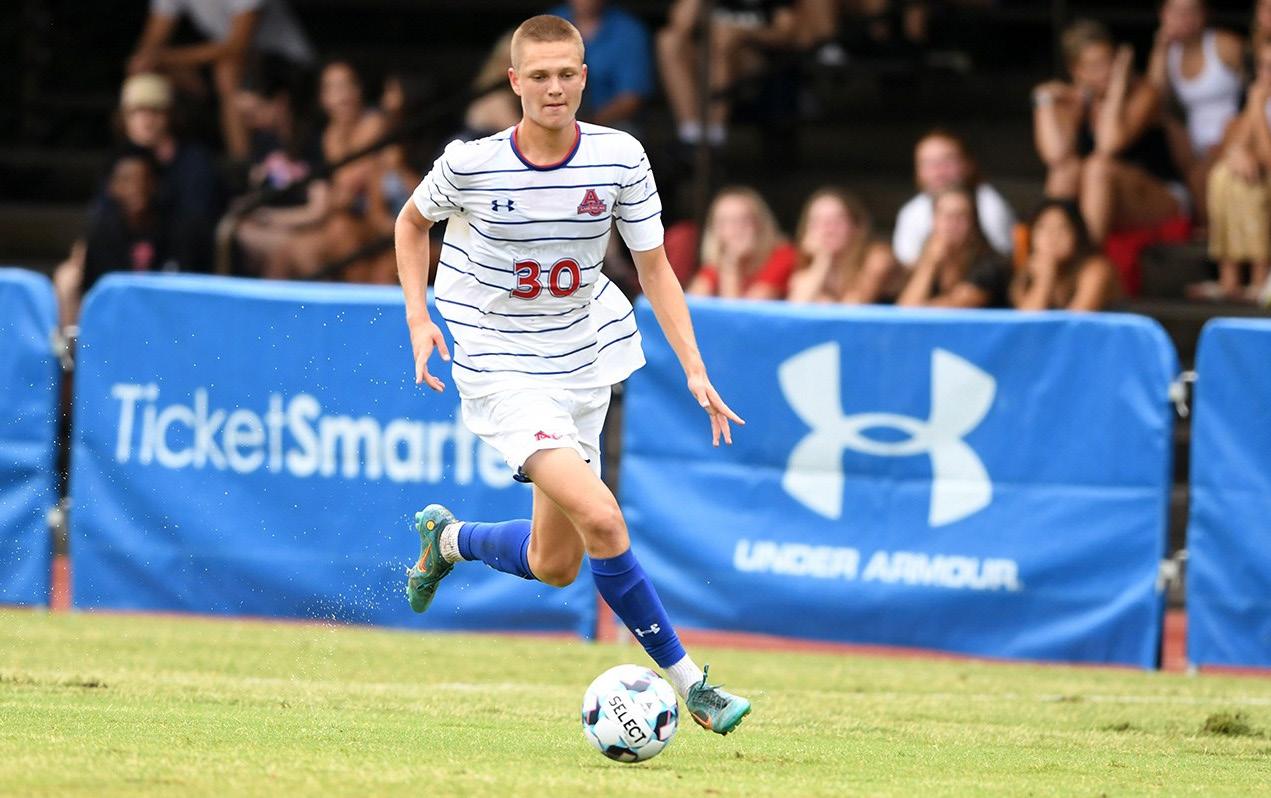
Q: As a team, how do you lift each other up when a season gets hard?
A: Well, it’s definitely important to lean on each other. Coming in as a freshman, everyone was immediately super welcoming which makes it easy to feel comfortable here. Just checking in on each other and trying to do things that are fun and bring us closer together.
Q: How do you stay motivated in the off season?
A: For me, I want to pursue soccer professionally after I graduate. So for me, it’s easy to stay focused in the off season because I’m thinking about that. Looking at the future and seeing what I want next from soccer is really important to me.
Q: What do you think is the biggest challenge college athletes are facing today?
A: Time. Having enough time to get everything done is something I think every single student-athlete faces. Our time is spread really thin, and in order to do that, I have to prioritize organization.
Q: What advice would you give someone who is considering becoming a collegiate student athlete?
A: You have to be organized. Practice that habit early on in high school before getting to college. Coming in organized and understanding what kind of schedule you’re going to have to get used to makes a big difference.
by Kyra Benzing-Plourde Sports Staff Reporter
Troy Elgersma, a midfielder on the men’s soccer team, is a standout freshman who saw action in 20 games his first season. His high performance on the field so early on indicates a successful college career with the Eagles. Additionally, Elgersma learned what it means to be a student-athlete off the field in a Division I program, shedding light on what it takes to balance a demanding schedule physically and mentally.
14
COURTESY OF OLIVIA HENLEY / AU ATHLETICS
COURTESY OF AU ATHLETICS
kbenzingplourde@theeagleonline.com SPORTS theEAGLE April 2023
Riley DeRubbo is
of the Eagles’ greatest assets on and off the court
Riley DeRubbo knows ball. The versatile junior guard on AU’s basketball team grew up outside of Pittsburgh, where her mother Jina has coached the Division III Washington & Jefferson women’s basketball program since before Riley was born.
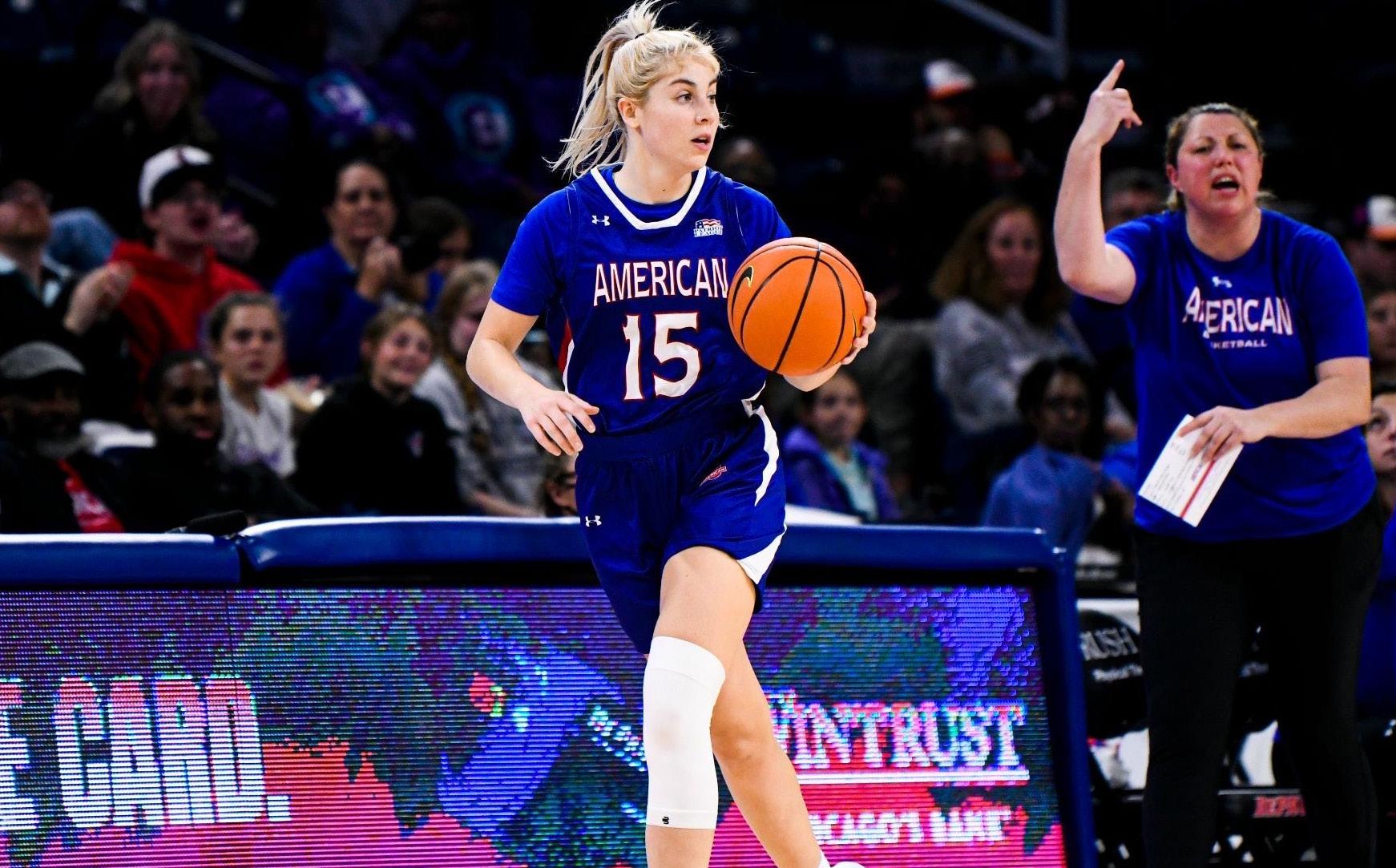
Growing up surrounded by basketball, DeRubbo couldn’t resist developing a love for the game.
“I started playing basketball when I was really young,” she said. “I always thought my mom’s players were the coolest people ever, ‘cause I would watch them … and I was like, ‘I wanna do that someday.’”
As DeRubbo grew older and her game steadily matured, her hoop dreams began to materialize. In a cruel twist of fate, however, she tore her ACL in her junior year of high school, causing her to miss five and a half months of playing the game she loves.
“Obviously that takes on a toll, more than just your body but your mental health as well,” she said. “I’m glad it happened … It really fuels you to get going and work as hard as you can.”
Despite what could have been a career-ending injury, DeRubbo returned to form her senior season and amassed 1,000 career points, becoming the 10th player ever to achieve this feat for the Trinity Hillers women’s basketball team.
As Division I offers finally began to come in, DeRubbo’s decision came down to Fordham University or American. DeRubbo ultimately decided to take her talents to the Bronx and join the Fordham Rams.
After one season at Fordham with only five total minutes of playing time, DeRubbo entered the trans-
by Marco Gacina and Silas Gaughran Bedell Sports Staff Reporters
fer portal and eventually landed at AU, the school she had initially declined.
“I just don’t think [Fordham] was the best fit for me,” she said. “And I wanted to be a little closer to home.”
DeRubbo received a more prominent role at AU than she had at Fordham — in her first season with the Eagles, she played in all 32 games, with AU’s season culminating in a March Madness tournament appearance for the first time since 2018. Though she was not yet the focal point of the team, DeRubbo was a Swiss Army knife that gave the Eagles whatever they needed in a moment’s notice off the bench.
In her junior year, DeRubbo oversaw an even bigger expansion of her role, from being a spark plug off the bench to the Eagles third leading scorer. However, this adjustment did not come without growing pains.
“I definitely realized it was going to be a challenge for me because it just wasn’t something that I had to do last year,” said DeRubbo. “It is very different, but I feel like my teammates do help me out a lot with that.”
Head Coach Tiffany Coll pointed to DeRubbo’s lifetime around basketball as the greatest indicator of her present and future successes.
“She grew up on the court,” Coll said. “She’s a coach’s daughter … so she’s always had that extra edge about knowing how a coach thinks.”
Coll also emphasized how DeRubbo’s coachability meshes perfectly with her vibrant personality. “She’s very charismatic,” Coll said. “People like her and socially, people want to be around her. She’s bubbly and
friendly and pretty popular. People just flock toward her.”
Coll entrusts DeRubbo to parlay her friendly, charismatic personality into a vocal leadership role going forward. “I’ve been telling her, ‘You’re really an influence to our team, especially our locker room, so everything you do needs to be exactly how we want our culture to be because you’re influencing it first hand,’” Coll said.
In January, DeRubbo’s breakout season came to an abrupt end due to injury. However, she impressed in her 14 games, starting all of them while averaging 8.4 points and 2.4 rebounds per game. The year was an overall difficult one for the Eagles, whose 9-22 season ended with a 29-point demolition at the hands of Holy Cross in the Patriot League quarter final.
Despite the persistent adversity this season, DeRubbo understands the valuable experience the team is getting.
“We have the talent. We really do. I think over time that experience will come,” she said. “The expectations are more about learning right now.”
With a hopefully healthy senior season on the horizon, DeRubbo is optimistic about what she and her teammates can accomplish.
“We do see the light at the end of the tunnel. It’s coming,” she said.
mgacina@theeagleonline.com
15
one
The Eagles' do-it-all guard has improved every season of her career
theEAGLE April 2023
COURTESY OF CHRIS KOHLEY
From wrestling for fun to becoming a Division I athlete, Max Leete tackles his dreams
school for education and his other sister a senior at the University in North Carolina. His family member's success made him want to find something to be passionate about – which he would soon discover.
It all started when Leete joined his brother and started wrestling. Ever since then, he has continued to wrestle through middle school and started to get more serious in high school traveling to national championships across the country. He started traveling to different states in eighth grade, traveling to 55 different competitions in the summer.
by Lauren Andreala Sports Staff Reporter
For Max Leete, his success and passion started long before coming to American University to be on the wrestling team.
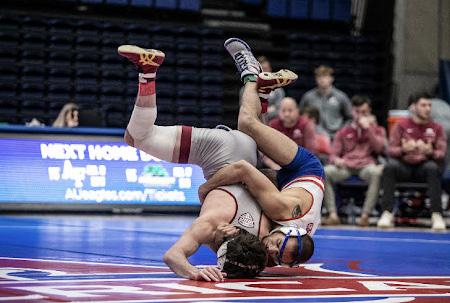
Growing up, Leete had parents who were both in athletics with his mom playing volleyball and his dad playing football. His three other siblings also have been pursuing their dreams with his brother in the marines working to become a police officer, his older sister at a private
In high school, he continued to compete on a national stage, beginning to be recruited by DI schools his freshman year. Towards the end of high school, the recruiting process came down to three schools: Brown, the University of Virginia and AU. Although he said he was happy to go to any of these schools, he ended up choosing AU because it made financial sense and was in a major city. He hasn’t regretted his decision.
“The wrestling program has a rich history and has a great network of support, alumni and brand new coaching staff supporting me in the journey so far,” Leete said.
It can be hard to maintain a balance between wrestling and school, especially with working out and meeting assignment deadlines, but Leete maintains a good balance.
In his downtime, Leete likes to do yoga, go to museums in D.C., with the Smithsonian Museum of Natural History
being one of his favorites, hiking and enjoying nature.
Looking towards the future of his wrestling career, Leete is currently working to complete a dual citizenship process to train and compete in the Dominican Republic on an international level, trying to perform on the biggest stage possible. Leete also works hard to maintain personal connections with other people on his team and the coaches. He is also a double major in women, gender and sexuality studies and justice and law as he believes both majors compliment each other and through each lens, intricacies can be discovered and applications can be made. He was interested in taking majors that could be useful in the future even as a future athlete, especially in DC.
Leete offers great advice for anyone who is interested in wrestling and this program at American. “I recommend making sure it’s something you love, with some people who don’t enjoy wrestling as much, there is a lot of sacrifice in order to be successful in the sport,” said Leete. He goes on to suggest that people who aren’t in a college athletic program don’t understand the challenges of being a DI athlete and creating a circle of people who will support you and your goals through adversity is an important factor. Leete represents the best of the wrestling program and is the epitome of challenge accepted.
landreala@theeagleonline.com
Morgan’s Message and The Hidden Opponent advocate for student-athlete mental health at AU
AU athletes raise awareness and fight for mental health support
by Penelope Jennings Sports Beat Editor
Lizzie De Guzman was just a freshman on the American University lacrosse team when she sustained an injury that is a critical blow to many athletes: an ACL tear. She suffered the injury during the abbreviated season in 2021. Not returning to play until late in the 2022 season, her mental health took a massive hit during this time off.
“It’s just been so normalized in the culture of athletics, just like putting your head down, being strong, like not opening up,” De Guzman said.
After seeing friends and athletes at other schools post about the student-athlete mental health advocacy organization Morgan’s Message, De Guzman got involved in the organization.
Morgan’s Message is named for Morgan Rodgers, who played lacrosse at Duke University and died by suicide after struggling mentally with not being able to play lacrosse due to a major knee injury. The organization, which was founded in 2020, was started by Rodgers’ mother to encourage other athletes in her situation to seek support and to eliminate the stigma associated with mental health issues in athletics.
Morgan’s Message works with another group called The Hidden Opponent, which was founded by Victoria Garrick. Garrick is a former University of Southern California volleyball player, who has been open about her own struggles with depression. Her organization is named for a TedTalk she gave in 2017.
De Guzman, now a junior on the lacrosse team, works alongside women’s soccer sophomore Olivia Simmons and freshman field hockey player Annie Shaw as Morgan’s Message ambassadors at AU. Additionally, they work with sophomore soccer player Jordan Mahony and senior runner Ana Keene who represent The Hidden Opponent.
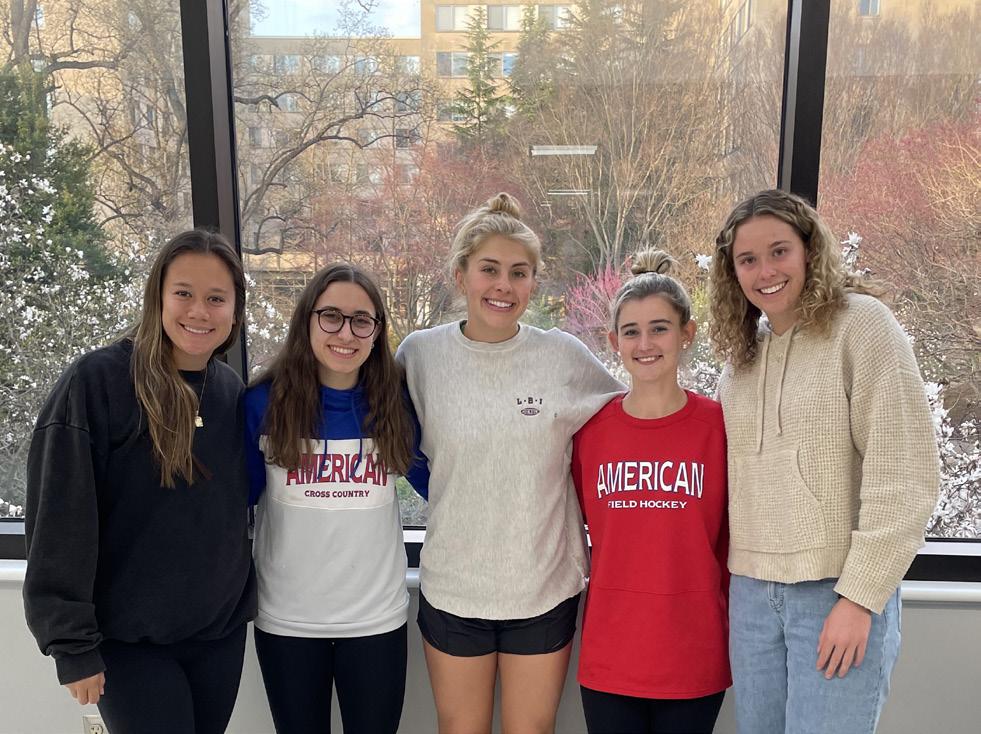
The issue of student-athlete mental health is close to home for Simmons. Rodgers went to her high school, and Simmons has experienced her own mental health struggles. She transferred to American from Purdue because of mental health issues, which eventually motivated her to start Morgan’s Message at AU, Simmons said.
The organization is broadly focused on fighting the stigma around talking about mental health and pushing student-athletes to seek help when they need it. More specifically, they want to work on creating spaces for studentathletes of color to talk about their own unique issues and encouraging more male students to participate.
The organization’s biggest concrete priority is having AU athletics hire a sports psychologist.
“Bring in a sports psychologist. It needs to happen,” Simmons said. “That is a top priority because a lot of bigger schools have that and have had that for a while.”
Since The Eagle interviewed Simmons on Jan. 30, AU has made progress towards hiring a sports psychologist. Every other Patriot League school currently has at least one person listed as a sports psychologist, according to their respective websites. AU had been working on hiring a sports psychologist for a while, but has never had one full time. Many other Patriot League schools have employed multiple sports psychologists for a number of years, according to their websites.
“The athletics department is in the process of hiring a Sports Clinician who will work out of the University Counseling Center but focus solely on our student-athlete population. This position was created in response to hearing from our student-athletes and staff that it was something they felt would enhance their experience at American,” associate athletic director of student-athlete well-being Katie Benoit wrote in an email to The Eagle.
“I didn’t even know what a sports psychologist was. I knew therapy was a thing but it never crossed my mind until I got to college and started seeing a regular therapist and a sports psychologist,” De Guzman said.
COURTESY OF OLIVIA SIMMONS
Because AU doesn’t have one yet, De Guzman sought out and paid for an outside sports psychologist on her own. “It’s now just crazy to me that every school doesn’t have that resource because of how difficult college athletics is, no matter what level you’re at.”
Morgan’s Message and The Hidden Opponent worked together to sponsor a Mental Health Dedication game during the April 12 lacrosse game against Navy this season. They encouraged unity between student-athletes at different schools by standing together in matching t-shirts and showing that the issue of mental health is bigger than the stat sheet or scoreboard.
“I know a lot of people don’t want to talk about their mental health. And that’s what ends them to start like going down that negative tunnel. A lot of younger student-athletes are taught to push through everything — like push through pain, push through physical injury. But mental injuries are not something that you should push through and that way, it’s better to get help,” Simmons said. pjennings@theeagleonline.com
theEAGLE April 2023 16
PHOTO COURTESY OF AU ATHLETICS
El futuro de la inmigración a los Estados Unidos y como la lucha sigue
by Sophie Cazares and Sarai Batallas El Águila Staff Reporters
En 2022, el programa de DACA vio muchos cambios legales. DACA, o “deferred action for childhood arrivals” en inglés, empezó en 2012 bajo la administración de Obama. Esto permitió que el Departamento de Seguridad Nacional no deportará a ningún joven que vino a los Estados Unidos de niño.
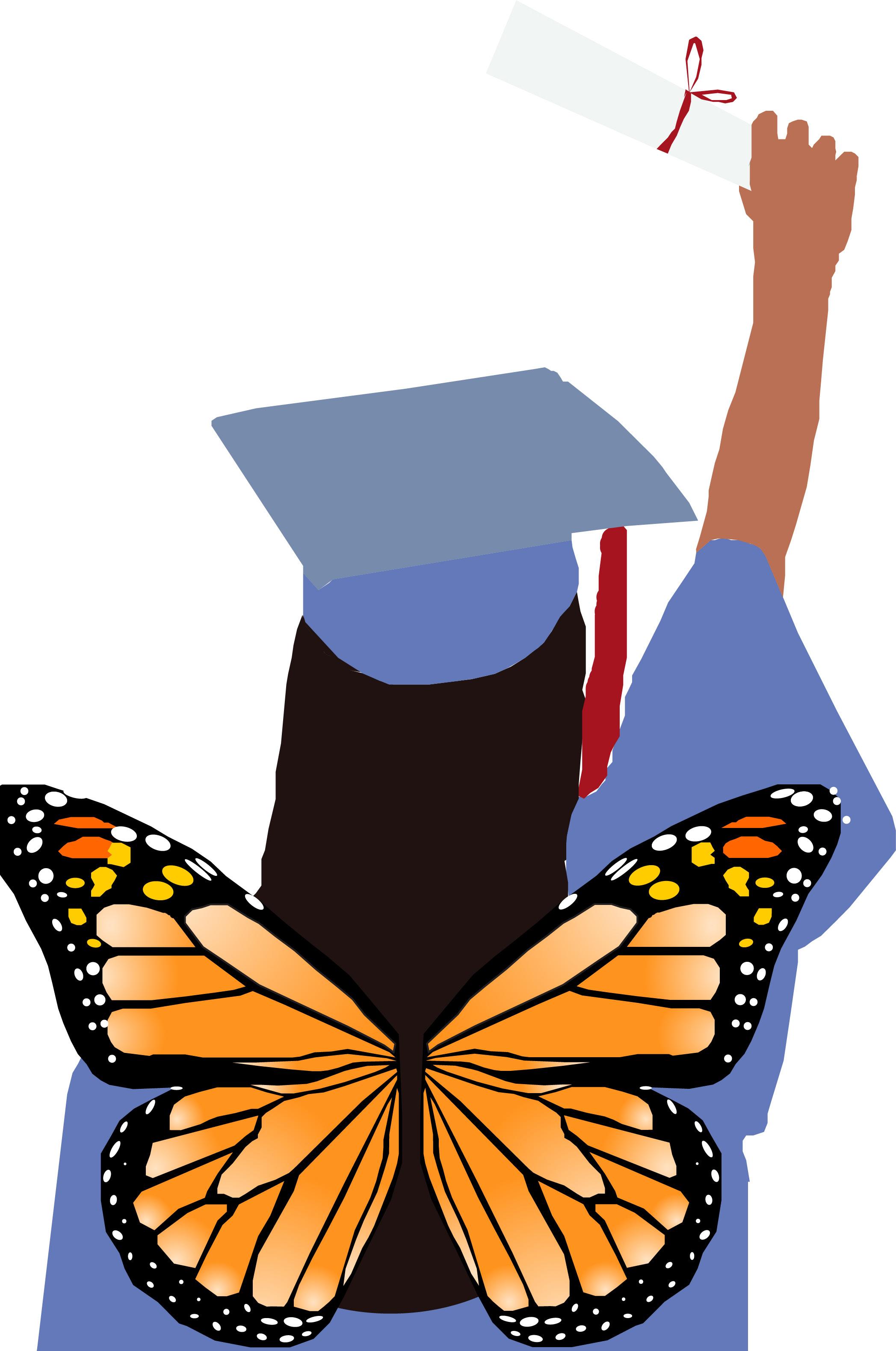
En años recientes, estas protecciones han cambiado. En octubre de 2022, la quinta corte de apelaciones decidió que DACA es ilegal. La corte del distrito en Texas llevó a cabo una sesión de acuerdo con la decisión de la corte de apelaciones, y también expidió la orden que el gobierno no puede dar DACA a ningún aplicante nuevo.
Estas decisiones significan que las personas que ya tienen DACA pueden mantenerlo, pero la gente en el futuro no va a tener acceso.
Para Jocelyn Lopez-Arias, una estudiante de segun-
do año estudiando química en el College of Arts and Sciences, las acciones realizadas por ICE en respecto a DACA golpean demasiado cerca de casa. Siendo hija de una inmigrante hispana indocumentada, ella observó de primera mano las luchas de no poder aclimatarse en un país que, hipócritamente, depende del trabajo de los inmigrantes para prosperar.
Inspirada por su experiencia con los peligros de ICE, comenzó un capítulo de United We Dream — la organización dirigida por jóvenes inmigrantes más grande en los Estados Unidos — en su escuela secundaria. Con el afán de encontrar una comunidad de estudiantes latinos igualmente apasionados, ella y otros miembros de la comunidad de AU comenzaron a planificar un capítulo de United We Dream en nuestro campus, debutando este otoño como Latinos En Acción. Como club afiliado a una organización que depende de movimientos de abogacía, Latinos En Acción participa en una cantidad requerida de acciones por semestre, recientemente incluyendo "Defund ICE" y "The Clock is Ticking for Citizenship".
Las acciones son una parte integral de nuestra comunidad, Jocelyn cuenta. “Quiero que las personas en este campus sepan que el poder está en las personas... Quiero que haya un cambio de perspectiva con respecto a la abogacía y que ellos sepan que pueden lograr cambios si trabajan allí”. Estos sentimientos se están volviendo cada vez más comunes via otras voces de abogacía dentro de la comunidad Latinx.
El Sine Institute, una organización que trabaja para llevar oradores invitados a American University, organizó una serie de conferencias con Alida Garcia. Garcia trabajó para la administración de Biden-Harris como asesora superior y ahora es la vicepresidente de defensa para FWD.us. La primera presentación con ella fue el 16 de febrero en la tarde.
Para esta primera charla, Garcia trajo al escenario a Erika Andiola, defensora progresiva nacional de justicia para inmigrantes.
El evento empezó con Edwin Santos, el co-presidente de la organización Latinos en Acción en American University, quien hizo las introducciones y dio la bienvenida.
Después de la introducción por Santos, la atención cambió a Garcia. Ella explicó lo que es DACA y sobre los nuevos cambios en los años recientes. Hay un requisito en Texas que impide que las personas obtengan acceso a DACA y por eso nadie nuevo tiene las protecciones. En
dos años, DACA terminará completamente porque se declara “ilegal”. 800.000 personas ya han recibido beneficios del programa.
“Este reglamento ha sido transformativo para estas personas y ha sido un éxito grande. El Dream Act no es una regla controvertida. Solo la política la está convirtiendo en un problema,” dijo Garcia.
Cuando Garcia terminó con su resumen de DACA, empezó a preguntarle a Andiola sobre su vida en el activismo. La primera pregunta fue sobre cómo Andiola llegó a esta posición.
Andiola explicó que su historia empezó cuando estaba en la universidad en Arizona. Ahí conoció a otros estudiantes indocumentados. Ellos crearon el Arizona Dreamer Coalition, y poco tiempo después, se dieron cuenta de que otros estudiantes indocumentados también se estaban organizando en otras partes del país. Estas organizaciones fueron parte del principio del movimiento en favor de programas como DACA.
“Si de verdad crees que debo ser deportado, deportame. Estoy sentado aquí en su oficina”, le dijo Andiola a un senador. Ella describió tácticas como esta que apoya la intensidad del movimiento.
En el principio, los activistas querían una propuesta de ley que ayudaría a la mayor cantidad de personas. Hay cerca de 11 million personas indocumentadas en este país. Pero no tenían el voto, y por eso perdieron el Dream Act en el senado en 2010. Obama usó su poder ejecutivo para empezar DACA y ayudar a la gente más joven. Esto fue una victoria.
“Es posible que perdamos mucho en el camino, pero son realmente estos actos de la gente común los que nos dan un salto adelante”, dijo Garcia.
Una historia con impacto que Andiola describió fue cuando ella empezó su carrera en el congreso. Explicó que estaba regresando a casa para celebrar, cuando ICE llegó y allanó su casa y sus padres fueron deportados en frente de ella.
“Todavía estamos luchando contra esta deportación hoy, tres presidencias después,” dijo Andiola.
Luego Garcia y Andiola empezaron a hablar de la época de Trump. Hablaron de cómo el panorama político ha cambiado, y cómo tenían que usar herramientas diferentes esta vez. Había un temor de que DACA fuera rescindido, porque fue una de sus campañas desde el primer día.
Ellas comentaron que Trump cambió el enfoque de inmigración, porque ahora la mayoría de gente piensa en la frontera. En realidad, la inmigración es el movimiento de gente, es mucho más grande de lo que él hace que sea, ellas explicaron. “El mundo no es estable. La gente va a seguir moviéndose y viniendo acá. Si decimos que somos el país más increíble del mundo, tenemos que alinear nuestra política con nuestras palabras”, dijo Garcia.
Al final del evento, Garcia y Andiola respondieron a preguntas de la audiencia. Hubo una pregunta de la influencia de los medios de comunicación, y más de Trump.
Garcia concluyó la conversación con algunos consejos para la audiencia. “Está arraigada en la humanidad. Salgan de sus burbujas. Y siempre traigan a la mesa las personas que se ven afectadas por estos problemas”.
scazares@theeagleonline.com
sbatallas@theeagleonline.com
EL
ÁGUILA
GRAPHIC BY HALEY DYMEK / THE EAGLE
theEAGLE April 2023 17
Con cambios recientes al programa de DACA, estudiantes y activistas comparten sus reacciones
Rompiendo estereotipos en las artes
American University y DC encabezan un abundante representación de perspectivas en la industria del arte
by Ava Agostinelli El Águila Staff Reporter
D.C. es el hogar de 170 nacionalidades y grupos étnicos, lo cual la convierte en una de las comunidades más diversas de los Estados Unidos, con una poderosa escena artística y cultural. En comparación con otras comunidades en los Estados Unidos, D.C. ha logrado grandes avances en la representación de artistas en y alrededor del propio campus de American University.
El 7 de marzo en el McKinley Building, la School of Communication organizó el “Salón De Las Artes: Contribuciones Creativas a La Cultura”, mostrando fotografías de estudiantes de licenciatura y posgrado de SOC, junto con una banda Colombiana de cumbia dirigida por mujeres, llamada La Marvela.
Leena Jayaswal, directora de la licenciatura en fotografía en SOC, eligió obras de estudiantes del curso de fotografía de bellas artes en el otoño de 2022 y de una muestra grupal en la University of the District of Columbia en noviembre. Los estudiantes de fotografía de AU han estado participando en esta exhibición anualmente desde 2009.
Diversity, Equity & Inclusion Committee organiza varios eventos cada semestre en SOC para el departamento de fotografía. Como uno de los primeros eventos de este semestre, Jayaswal dirigió la exposición titulada "Identidad". La exhibición se dividió en dos pisos: el primer piso era para obras en color, y el segundo piso era para obras en blanco y negro.
Travis Hopper, un estudiante de posgrado con especialización en fotografía en SOC, mostró un autorretrato titulado “Wolf Palm Reading”. Hopper se inspiró en las “líneas de vida”, en la palma de la mano y sus habilidades supersticiosas para averiguar la personalidad y la información de uno. Hopper sintió que el lobo representaba su personalidad, ya que es un ser valiente pero amigable. La posición de las manos de Hopper resaltó sus líneas de vida mientras proyectaba una mirada amenazante como
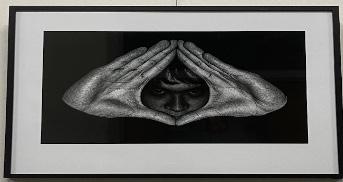
la de un lobo a través de sus ojos.
Kamryn Olds, un senior estudiante de pregrado en SOC, mostró varios trabajos que representan sus luchas contra la ansiedad. Se inspiró en el pintor realista Francés Gustave Courbet y en patrones de capas de obras psicodélicas.
Después de la exhibición, La Marvela, una banda de cumbia con sede en D.C. liderada por mujeres, tocó una colección de canciones con instrumentos tradicionales Colombianos junto a una mesa llena de comida Colombiana. La Marvela tiene como objetivo combatir los estereotipos de género de la industria musical dominada por hombres de su tierra materna. La Marvela renovó los ritmos tradicionales con una perspectiva más joven e incorporó instrumentos de otras culturas Latinas. Sus miembros no son solo de Colombia, algunos miembros son de Puerto Rico. La diversidad de sus antecedentes inspiró los tipos de instrumentos y ritmos que tocan, como la incorporación de flautas indígenas y la influencia de la música bomba Puertorriqueña. El DMV tuvo otros esfuerzos pioneros recientes para romper barreras y estereotipos en la industria de las artes. El Washington Ballet, actualmente en la mitad de su temporada 2022/2023, es una de las pocas compañías de ballet importantes en los EE. UU. que pone la representación al frente de su misión. Rafael Bejarano, miembro de la compañía del Washington Ballet, siente que ha encontrado una comunidad de aceptación que de otro modo no habría encontrado en ningún otro lugar.
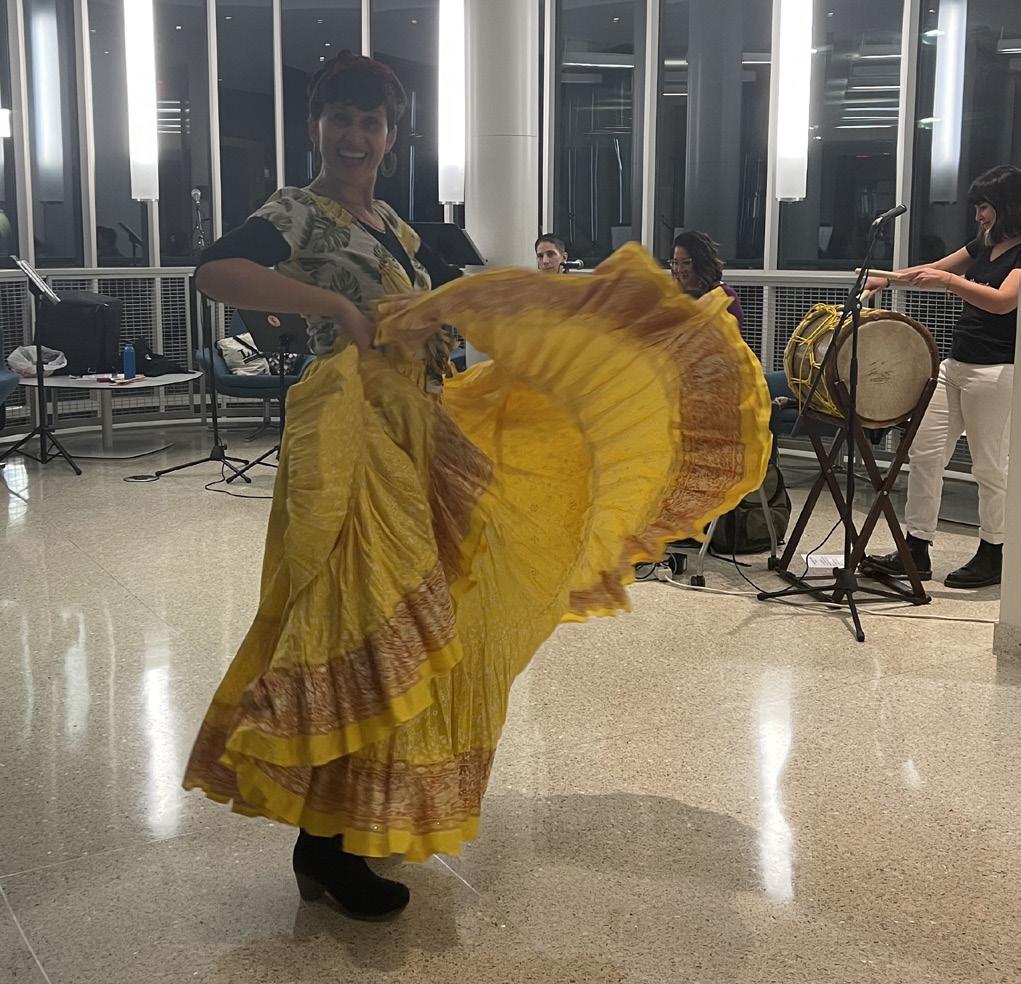
“Cuando vine a los Estados Unidos fue un choque cultural para mí. Yo no hablaba el idioma en ese entonces”, dijo Bejarano. “Me uní a la escuela y tenía un par de amigos que tenían herencia hispana. Me sentí más incluido en la compañía una vez que me uní a la compañía de estudio y luego a la compañía principal. La mayoría de mis amigos son Cubanos ahora”.
Bejarano creció en Guadalajara, México, y vino a los EE. UU. para mejorar su formación en ballet. Se unió al Washington Ballet después de tres años en la Escuela de Ballet de Washington.
“Creo que el Ballet de Washington tiene una larga intención de diversidad dentro de toda la organización” dijo Bejarano. “Desde mi experiencia trabajando con el Washington Ballet, una de las compañías más grandes de los EE. UU., he visto el esfuerzo de cómo podemos llegar a otras comunidades que tienen poco acceso a este tipo de arte”.
Carmen Ruzza, profesora de AU en el programa de lengua Española, participa en las clases abiertas del Washington Ballet. Allí siente que el ballet se ha hecho más accesible para todas las edades, nacionalidades y capacidades físicas. Aaron Jackson, profesor de ballet en el Washington Ballet, organiza clases de ballet abiertas que atraen a profesionales y principiantes de todo el país, incluso a los propios profesores y estudiantes de AU.
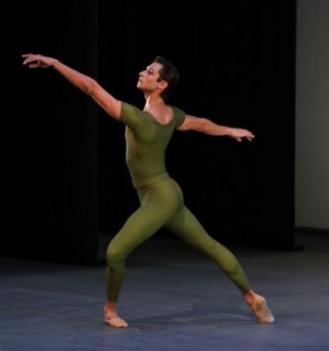
“En lo que respecta al profesor Jackson, el ambiente es maravilloso” dijo Ruzza. “Acepta a todos los alumnos siempre que tengan pasión y disciplina hacia el ballet. Tomó clases con personas de diferentes culturas y edades. De hecho encontró que acoge a aquellos alumnos cuyo nivel no es tan intermedio y les motiva con mucha ilusión a seguir la clase”.
En una entrevista con Andile Ndlovu, coreógrafo del Washington Ballet, explicó cómo la oportunidad de crear un nuevo trabajo no era común para comunidades como la suya en una industria tan eurocéntrica. Ndlovu enfatizó la importancia de abrir espacio para creadores que históricamente han estado subrepresentados y diversificar las artes.
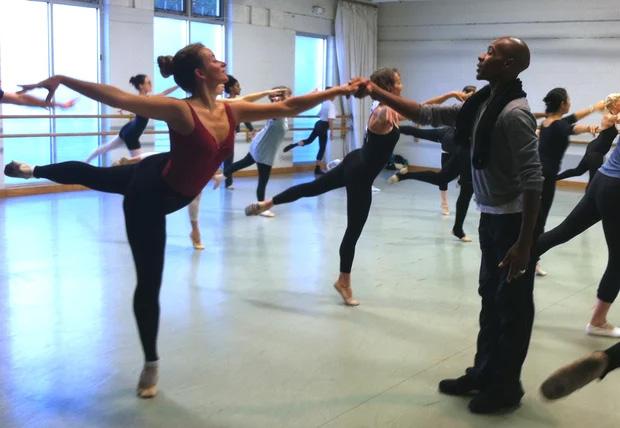
“Espacios de equidad para artistas negros: creadoras negras, creadores negros”, dijo Ndlovu. “Necesitamos programas que sean actuales. Narrativas de hoy que son narrativas actuales de historias negras, narrativas de historias latinas, historias asiáticas. Necesitamos más de eso, en lugar de solo las narrativas eurocéntricas que nos han alimentado durante tanto tiempo”.
El DMV continúa liderando el esfuerzo para mostrar comunidades históricamente subrepresentadas. La variedad de perspectivas ha agregado valor a la escena artística de D.C., atrayendo a artistas y espectadores de todo el mundo.
aagostinelli@theeagleonline.com
18
theEAGLE April 2023
COURTESY OF AVA AGOSTINELLI
Clase Abierta de Ballet de Aaron Jackson en El Washington Ballet
Rafael Bejarano en El Washington Ballet COURTESY OF @XMBPHOTOGRAPHY
“Wolf Palm Reading” de Travis Hopper
COURTESY OF AVA AGOSTINELLI
Profs and Pints: Evento sobre la crisis en Brasil y Perú
by Aline Behar Kado El Águila Staff Reporters
Trás las manifestaciones democráticas en Brasil y Perú, el fundador y CEO de Profs and Pints, Peter Schmidt, decidió invitar a Fulton Armstrong, un profesor adjunto en el Center for Latin American & Latino Studies de la School of International Service en American University, para que de una presentación.
Armstrong ha trabajado para el gobierno americano por muchos años como investigador y analista político, enfocándose primariamente en temas latinoamericanos. Al iniciar su presentación, Armstrong dejó claro que esto no era una clase ni una conferencia, era un “briefing” de las situaciones en los dos países.
“Sus síntomas, sus crisis actuales son síntomas simplemente de un fenómeno muy arraigado”, dijo Armstrong. “Pero [los dos países] tienen bastante en común con estos impulsores subyacentes, diferencias históricas, sociales y étnicas, incluso si no tienen la misma estructura y desafíos económicos”.
Los temas que destacaron en su sesión informativa fueron los ataques recientes a la democracia, la inestabilidad política en latinoamérica y los problemas latentes que causan estas crisis y sus posibles soluciones.
Armstrong se basó en los bruscos cambios de poder político en países latinoamericanos y se enfocó en las llegadas a poder de Jair Bolsonaro y Luiz Inácio Lula da Silva en Brazil y Pedro Castillo y Dina Boluarte en Peru.
“Las manifestaciones no son solo atreverse a enfrentar los escudos de la policía, son gente modesta, indígenas que son políticamente activas”, dijo Armstrong sobre Perú. Continúo diciendo que las manifestaciones eran una parte del ejercicio de poder democrático en
esta región, sin embargo, culpó a otras causas del aumento de manifestaciones e inestabilidad política en la región, tomando como ejemplo la invasión del Palácio do Planalto el 8 de enero en Brasilia.
“Las causas fundamentales son en general los problemas internacionales no resueltos del pasado, corrupción de élites y gobiernos, desigualdad económica, choques externos en el comercio y la pandemia y liderazgo hemisférico”, decía su presentación.
Elaboró más sobre el tema de liderazgo e inestabilidad gubernamental diciendo que es a causa tanto de los líderes como de los mismos partidos políticos que hayan habido tan fuertes cambios de poder y dio como una solución la mejora de instituciones gubernamentales y privadas.
“Cuando sucede eso, entonces tienes estos cambios enormes, es como si el país no tuviera raíces”, dijo Armstrong. “Mientras que si tienes instituciones fuertes fuera del gobierno, así como de la sociedad civil, los medios, las raíces pueden crecer, y evitan que los cambios sean demasiado drásticos, demasiado radicales”.
Armstrong dió su análisis de qué puede hacer los Estados Unidos para apoyar la crisis en latinoamérica. “Creo que lo primero que podemos hacer es mejorar la democracia y mejorar nuestra propia democracia para demostrar su eficiencia, demostrar su adaptabilidad”, dijo Armstrong en una entrevista para El Águila.
Recalcó que en años recientes, especialmente con el asunto de Donald Trump y las elecciones del 2020 en Estados Unidos, el sistema democrático en todo América ha sido atacado.
nos hemos ido hacia la deslegitimación de puntos de vista opuestos”, dijo Armstrong.
Su solución es buscar la manera de restaurar el sistema democrático en Estados Unidos para dar el ejemplo a latinoamérica y además brindar más apoyo a la región, dado a que, según él, los Estado Unidos es un país latinoaméricano por su alta población Latina y su ubicación geográfica. Pero, aún hay problemas en recaudar interés por la región en el gobierno y en las universidades.
“No creo que la imagen de América Latina, la hermosa cultura y los aspectos únicos de su cultura, reciban suficiente atención entre los especialistas en política exterior y de América Latina en general”, dijo Armstrong. Él alude esto a una burbuja y cómo él piensa que salir y visitar Latinoamérica y realmente envolverse en la cultura es una aventura en sí misma.
“Ir y ponerse en lugares fuera de su zona de confort es un desafío”, añade Armstrong. “Es incómodo, pero es enriquecedor. Es lo que realmente hace que algo como América Latina sea muy divertido”.
Sobre la presentación hubo mucho que decir y apreciar, y Schmidt, el organizador de esta y muchas otras presentaciones en D.C., reconoce la importancia de brindar sesiones informativas a estudiantes y académicos en esta ciudad.
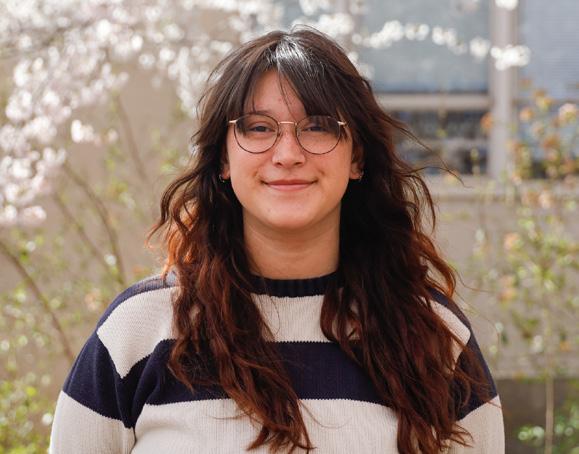
“Solo trato de informar a las personas para que se comprometan a tomar decisiones políticas sabias y, ya sabes, D.C. es una ciudad donde se está haciendo política”, dijo Schmidt en una entrevista para El Águila. “Entonces, si he estado poniendo ideas e información importante en el éter aquí estoy feliz de hacerlo”.
scazares@theeagleonline.com
bamadorrivera@theeagleonline.com
Opinión: American University’s opciones de menú problemáticas
by Paige Craig El Águila Opinion Columnist
Este semestre, American University abrió un nuevo restaurante en East Campus. Durante el día, Freshens ofrece ensaladas, batidos de frutas y panes planos a la parrilla, entre otras opciones. A las 9 p.m., CraveTown, una nueva opción para cenar por la noche, toma el control.
Como alguien que se estaba cansando de las pocas opciones ofrecidas aquí en el campus, yo estaba emocionada de ver el nuevo menú. En las opciones proveídas en el menú, CraveTown esta categorizado como cocina mexicana y americana, así que me intrigó ver qué comida de estilo mexicana tenían para ofrecer.
Después de ver el menú, no fui impresionada por la comida de “estilo mexicana” que se ofrecía. Además, me sorprendieron algunos de los nombres de las opciones de comida. Por ejemplo, el tazón de arroz titulado “mexicano” tiene frijoles negros, salsa, ranch de chipotle y arroz blanco. Esta es una visión demasiado generalizada y estereotipada de la comida mexicana. Al ver estas opciones, no me sorprendió ver la otra opción que también tenían. Todas eran las mismas opciones de comida que he visto en los restaurantes de comidas rápidas.
Sin embargo, la opción el “On The Border Crunchadilla”, dejó a mis amigos y a mí en un silencio conmocionado. Al principio, pensamos que habíamos leído mal el título, pero allí estaba escrito en blanco y negro. ¿Por qué un plato tiene que llevar el nombre de la frontera? A diferencia de las otras opciones que se sirven en CraveTown y Freshens como el “Nashville Hot”, que
“En lo que nos hemos convertido ahora es algo así como lo que yo llamo la posición latinoamericana de la política, y es que nos hemos ido hacia el personalismo, tiene coleslaw y salsa picante de Nashville o “Chicken Avocado Crunchadilla”, que tiene, lo adivinaste, pollo y aguacate, la crunchadilla “On the Border”, no da ninguna indicación de lo que hay en el plato. Simplemente tiene un término audaz y potencialmente ofensivo para cualquier estudiante que haya lidiado con problemas de migración en el pasado.
¿Por qué asociamos uno de los únicos alimentos Latinos en el menú con la frontera? ¿Y cuál es la necesidad de hacer esa comparación?
Descubrí que Freshens no es exclusivo en el campus de AU, también está ubicado en aeropuertos y campus es de todo los Estados Unidos. A pesar de que AU no puede cambiar el menú, pueden decidir si tener un menú que sirve alimentos con nombres ofensivos a sus estudiantes. Sin embargo, incluso con los platos que AU puede controlar, el personal del comedor sigue encontrando la manera de bautizar los platos con nombres culturalmente insensibles. Por ejemplo, el Terrace Dining Room sirvió un plato llamado “Buddha 's Delight”, que es un salteado vegano. Incluso cuando la universidad puede elegir los nombres de lo que está en el menú, todavía eligen poner algo que es culturalmente insensible.
AU no es la única universidad que muestra controversias en sus elecciones alimenticias. La Universidad de Nueva York intentó (y fracasó) hacer un menú para Black History Month. El menú ofrecía una sección de bebidas que incluían “Kool-aid” y “watermelon-flavored water”.Las bebidas fueron retiradas inmediatamente tras la reacción de los estudiantes.
Entonces, ¿se debería perder toda la esperanza? No necesariamente.
Mientras los servicios de comedor de AU carecen de sensibilidad cultural, el Bridge Café es capaz de apreciar las culturas de la comunidad de AU.
Realizaron un evento llamado “Un Semestre Sin Ti”, una semana de bebidas especiales para celebrar Hispanic Heritage Month.
Para celebrar a la población estudiantil Latino, The Bridge Café hizo un menú de bebidas inspirado en el nuevo álbum de Bad Bunny titulado “Un Verano Sin Ti”. Las bebidas tenían nombres creativos que hacían referencia a los títulos de las canciones. The Bridge pudo crear un menú de bebidas único que no tenía nombres ofensivos o políticamente cargados. Además, cada una de las bebidas giraban en torno a la cocina tradicional latino, como tres leches, horchata, agua fresca, etc.
Los alimentos culturales deben ser respetados y representados de manera justa o por lo menos, sin llevar el nombre de algo tan politizado como la frontera. Es triste que American University tenga dificultades encontrando formas apropiadas de incorporar diferentes culturas en las comidas que se sirven aquí en el campus.
19 theEAGLE April 2023
pcraig@theeagleonline.com
Profesor adjunto de American University, Fulton Armstrong expusó sobre las crisis políticas en Latino America, enfocándose en Brasil y Perú
MADDIE MILLER / THE EAGLE
Opinion: Improving DC’s student governments begins with a study of their faults
True improvement is unlikely to be met without thorough analysis of their failures.
minimal policy information, yet as it cannot enact policy changes itself, administration must be more open to student voices.
Power struggles within the George Washington University Student Association are clear as well, most notably between the SA’s president, Christian Zidouemba, and his cabinet members. Zidouemba was recently tried in the SA student court by a cabinet member, who attempted to declare his presidency illegitimate. In response to campus frustration, a student court representative said, “Don’t hate the player, hate the game,” as reported by Washingtonian Magazine. Although a common phrase, this mindset has no place in student governments, as it deflects responsibility and facilitates the abuse of procedure.
Association recently attempted to reevaluate its priorities and abolish its government. However, the reform fell short of the necessary 25 percent voter turnout needed for the constitutional referendum. As Georgetown’s SA strayed from student priorities and was instead used to build resumes, undergraduate belief in action dwindled. This resulted in inaction, even in abolishing the root of on-campus dysfunction. Now, the university’s high concentration of passionate government and foreign service majors refrain from taking part in the system they are affiliated with, instead of working to improve it.
by Rebeca Samano Opinion Columnist
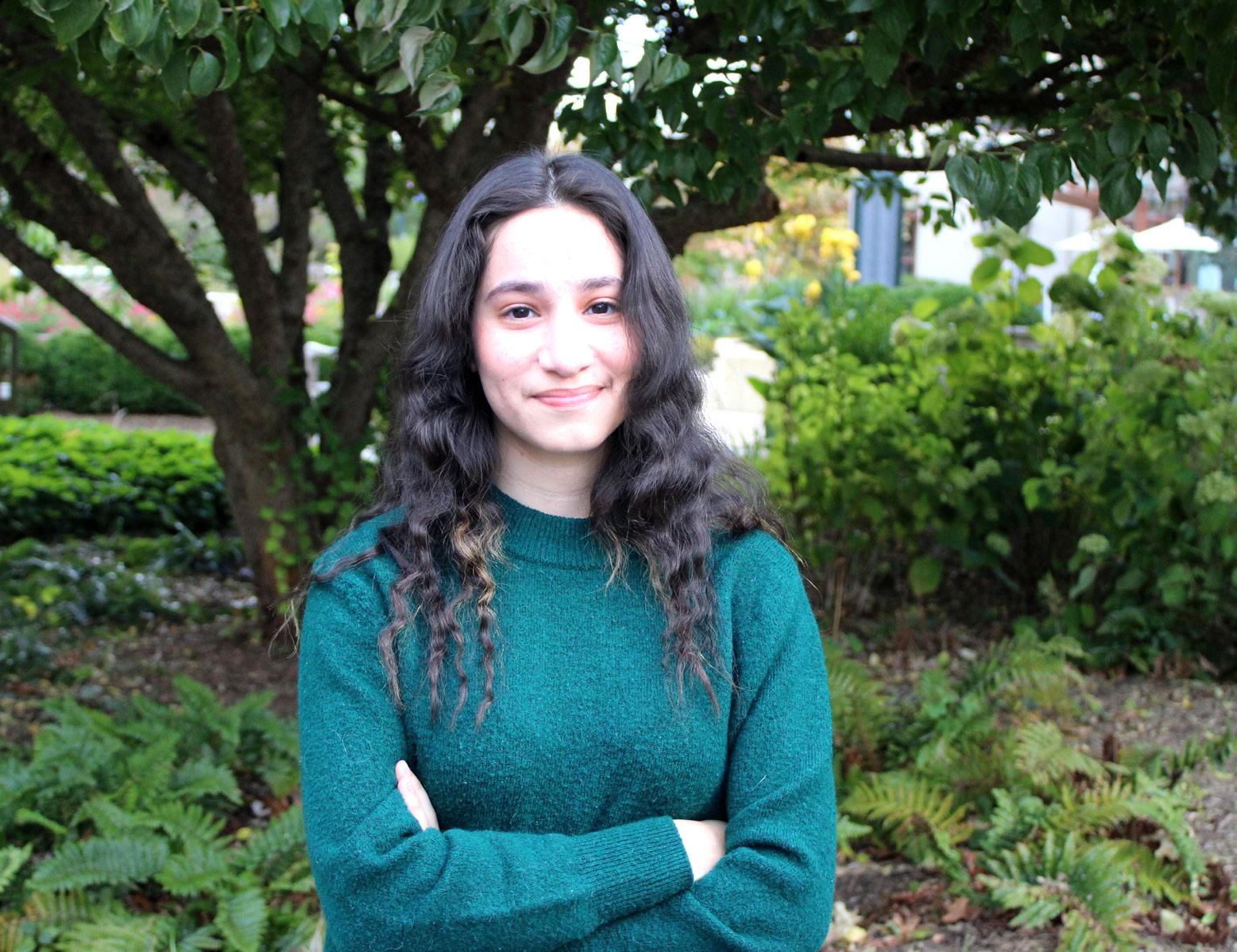
The student governments in D.C., despite representing colleges with large student populations in political science and international studies, lack substantial policy action. American University, George Washington University and Georgetown University have all faced recent calls to abolish their student governments. These calls are warranted by this lack of policy action and unmet goals of “integrity, professionalism, and transparency,” as well as failure to “advocate, allocate, advertise, and assist,” in undergraduate needs. Although change is necessary, organized student leadership should not be completely abolished, as it would lead to increased administrative control. As they stand, D.C.’s student governments may leave dangerous power vacuums and disorder in higher education.
An analysis of the student governments’ shortcomings may be more beneficial than complete abolition; however, D.C.’s student governments have done little to persuade undergraduates against abolition. The AU Student Government specifically lacks transparency. SG leaves students in the dark, as it has not formally updated its policy reports listed on its website since 2020.
The available policies proposed by SG contradict the changes that have been made at AU. In one instance, SG presented The
Affordability Roadmap: Concrete Steps for a More Affordable AU, only for AU’s tuition to increase in the years since. Although SG alone can’t change tuition costs or administrative policies, when their proposals directly contradict university actions, it shows SG’s inability to advocate for students. In falling short of the primary goal of advocacy, mistrust rightfully builds among the student body but breezes past the possibility of analysis.
Effective student governance not only requires analysis but collaboration from administration. Currently, AU makes little room for student voices. Without administrative cooperation, little can be achieved. Struggles within SG are also a prominent issue in effective student governance, as observed by repeated speaker elections and a dissent on the misuse of power and ethics from the Judicial Board. The lack of available policy reports and consensus hinder the prioritization of undergraduate issues, but the policy that is developed is still halted by administrative barriers. Both SG affairs and administration then leave these patterns of dysfunction without a resolution. SG creates barriers to undergraduate advocacy by providing
Members of student governments have the privilege to change “the game” more than any other student group on college campuses. Moreover, there is little excuse for their complaints without accompanied action. Suggesting undergraduates “hate the game” is a misuse of an office position and facilitates the drama that leads news outlets to pick up student government stories.
Lack of participation in elections, especially at a university known for its political prestige, is cause for significant concern. This low turnout also occurs at AU, with only 10 percent of students voting in the fall 2022 election. This reflects a larger distrust in political institutions, as only 27 percent of youth in the United States cast a ballot in 2022. Although considered high for youth voters, undergraduates and student governments can work on these voting issues on a smaller scale to build institutions that work for its people and push for accessibility. University administrations, however, must make substantial room for student voices for student governments to function.
Other members of GW’s SA and undergraduates at the university seem to blame its own governing documents for creating conflict and disorganization. This provides little support for future use of these procedures. While SA has now developed a committee for the improvement of its governing documents, this must be in conjunction with an evaluation and adherence to its priorities. Organized student leadership should still be put in place to prevent greater administrative discretion, but this does not endorse the continued use of faulty foundations. Leadership in student government can and should take accountability while acknowledging errors in the system, instead of continuing to operate on the same foundations that lead to government and public unrest.
The Georgetown University Student
All three student governments reflect that attempting to implement the same systems we see play out in D.C. and in our country are ineffective and perhaps dooming. The lack of transparency and professionalism present at all three schools go hand in hand with this and result in public distrust. These issues are often systemic, like that of voter turnout, but the analysis of such dysfunction with collaboration and movement away from current governing documents can create change on our smaller scales. Although these changes certainly take time, administration, undergraduates and especially student government leaders should examine policies for improved efficiency and cooperation, instead of playing by a system that only works on a resume. At higher institutions with political focus, we must use our privilege to improve our governance.
20 theEAGLE April 2023
rsamano@theeagleonline.com
Rebeca Samano is a sophomore in the School of Public Affairs and a staff columnist for The Eagle.
OPINION
IZZY FANTINI / THE EAGLE
Lack of participation in elections, especially at a university known for its political prestige, is cause for significant concern.
Opinion: AU must update its emergency preparedness plans
by Alice Still Opinion Columnist
In the entirety of 2022, there were 647 mass shootings in the United States. In the first six weeks of 2023, there were 71. While shootings in K-12 schools have unfortunately been a relatively common occurrence, shootings at higher education institutions were far less frequent until a few months ago.
Since 1996, there have been 12 college shootings in which there were three or more fatalities. This school year, however, there have been two deadly mass shootings on college campuses thus far — first with the tragedy at the University of Virginia on Nov. 13, and again just a few months ago at Michigan State University on Feb. 13. These two incidents of gun violence raise concerns for students at American University, many of whom do not know what safety protocols are in place to prevent an incident like this.
In the days following the MSU tragedy, I began hearing conversations across campus about what to do in the case of
an armed assailant breaching University buildings. It was not until then that I realized I had virtually no understanding of what the University’s protocols or procedures are in the case of an emergency like this. In the wake of these horrific events, students, especially first-years, should have been promptly informed about AU’s safety protocols.
Although I understand that in the case of an incident such as an active shooter there is no way to be perfectly prepared, AU’s “emergency preparedness” website merely provides students with a oneparagraph description of a one-minute video by the Department of Homeland Security guiding students to “run, hide, fight.” Upon further research, an active shooter preparedness memo from over six years ago, as well as a security resource notification from October 2022 can be found.
On March 16, the AU community received a memo from Phillip Morse, assistant vice president of University police services, reinforcing these safety plans. However, each of these resources simply restates the same information from crossing directly through southeastern D.C. neighborhoods.
a few videos or articles, none of which are AU-specific. The resources are certainly useful, but they are painfully insufficient. Additionally, these pieces of information have yet to be consistently relayed to the AU community or updated with new information.
It is imperative the AU community is well-informed about emergency procedures in the hopefully unlikely event that tragedy strikes our campus. “It will never happen here” is an all too commonly used phrase given the habitual acts of gun violence perpetuated all across the country every day. Without compromising protocol, of course, it would benefit the University to reexamine its active shooter preparedness documents to include information addressing AU campus-specific details.
by Jelinda Montes Assistant Opinion Editor
The United States is the land of the free, as long as those free have cars and homes. Car dependence in America is an undoubtable reality. The image of a sixlane road lined with fast-food restaurants and gas stations is seen all across the country as the byway between residential and commercial areas.
D.C. is not divorced from this, and Black communities bear the deadly brunt of car-centric neighborhoods everyday. It is no coincidence that Ward 3, one of the wealthiest and whitest areas of D.C., had no traffic deaths in 2021, and Wards 7 and 8, which have majority Black populations, hosted almost half of all D.C. traffic fatalities in 2021.
These majority Black neighborhoods are designed with the traffic concerns of D.C. commuters in mind, not the residents themselves, by having a much larger share of high-speed roadways and highways
With a general lack of mixed-use zoning permitted in sprawling cities and suburbs alike, commercial and residential zones are geographically separated. This feeds the need for cars to get from the home to work, school and other establishments. The image evoked at the beginning of this piece is referred to as a “stroad”: a portmanteau of street and road. Urban planner Charles Marohn Jr. coined the term to describe “multi-laned thoroughfares you encounter in nearly every city, town, and suburb in America.”
A stroad is the combination of a street, which involves people interacting with commercial and residential areas, and a road that is built with high speed limits akin to a highway. Although they are often busy connectors of business and residences, most stroads don’t have well maintained sidewalks or safe crosswalks — making pedestrians’ travel either unsafe or impossible.
Stroads exist because of urban sprawl and non-mixed zoning areas where residential areas are far enough away from all other places that people need a car to accomplish daily tasks. If sprawling cities and towns were designed to be denser, stroads wouldn’t be necessary, but dangerous, connectors.
Urban sprawl exists because of American freedom — freedom to intricately craft barriers restricting minorities and lower classes from popping the perfect suburban bubble. Freedom
The first sentence of the final paragraph of the “Active Shooter Preparedness” memo reads: “the biggest obstacle to safety and security is complacency.” I implore the University’s security officials and the administration to take their own advice and avoid complacency. By streamlining communication to students and the to influence zoning policies and even carve out portions of cities to be built like suburbs plays a role, too.
community as to what preventative systems are in place and making the necessary changes to current protocols, the University has power to act. Given the uptick in shootings on college campuses, AU must take action to alleviate students’ fears and ensure that everyone is, without question, aware of the security measures and protocols in the case of an active shooter.
Alice Still is a freshman in the School of Public Affairs and a columnist for The Eagle.
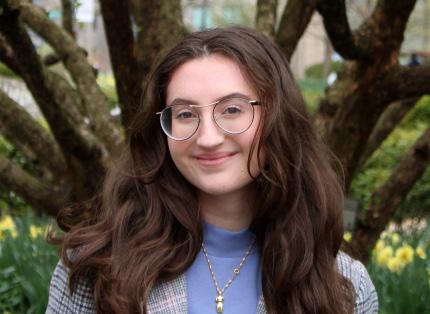
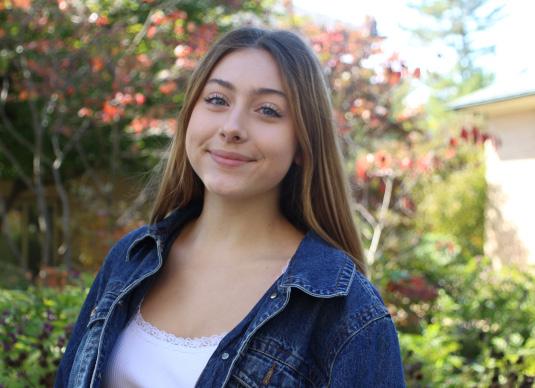
astill@theeagleonline.com
— not
This is seen in D.C.’s R-2 zone definition, which intends to “protect these areas from invasion by denser types of residential development.” This type of residential zone only allows development of semi-detached homes on medium-size lots, which essentially restricts housing designs other than two single-family homes connected by a shared wall. The only exceptions in R-2 zoning are for completely detached single family homes. Residential apartment zones that are meant for medium-to-high density living are quite few and far between in D.C., with Wards 4, 7 and 8 having practically no zones permitting such high density development.
Exclusionary zoning practices create artificially inflated housing markets that only allow the development of residential zones in specific areas. Such residential zones are often specified for only detached single-family homes, preventing more affordable multi-family homes and apartments from being constructed and restricting the kind of people who can live in a certain area.
Dense living is more efficient, costeffective and community-oriented, so why isn’t there more incentive to build mixed-use and apartment friendly areas that allow residents to live, work and consume without the need for a car?
The answer is easy — urban sprawl requires a car, so as long as the car lobby
remains powerful, mixed-use zoning and quality alternative transport will not be supported or funded. Without mixeduse zones, housing will continue to be segregated between those who can afford homes and those who need to rent.
The car lobby’s power is backed by the even larger oil lobby. Koch Industries is a conglomerate that produces gasoline, asphalt and various other car parts; the Koch brothers fund a libertarian lobbying group called Americans for Prosperity which has effectively lobbied against mass-transit projects in over seven areas across the country.
To many, an expensive SUV and a sixbedroom house represent the American dream, a dream sold to us by car companies and housing developers. This dream was born out of the racist “white flight” desires of rich and middle-class white Americans to carve out their own exclusionary utopias, where the barrier to entry is artificially high housing and vehicle prices.
Awareness about such systematic exclusionary urban planning, funded by the car and home development lobby, is the first step in creating more equitable and efficient cities and towns in the United States.
Jelinda Montes is a junior in the School of Public Affairs and School of Communication and the assistant opinion editor for The Eagle.
jmontes@theeagleonline.com
21 theEAGLE April 2023
In light of the recent shootings on college campuses, AU students raise questions on campus safety
Opinion: The US is designed for cars
people DC is not an outlier when it comes to problematic urban design
LIA CHIEN / THE EAGLE
IZZY FANTINI / THE EAGLE
Opinion: What it’s like being an immunocompromised student at AU
Every semester, I’ve tried to get accommodations from the Academic Support and Access Center, but a current doctor must provide a diagnosis and make recommendations for ASAC to provide accommodations. Here’s the problem: I don’t have a doctor because even medical offices have removed coronavirus precautions. My medical records are all over the place from moving. I cannot afford to run diagnostic tests again. The Student Health Center can’t provide the recommendations. The list of hoops to jump through puts official accommodations out of reach. But even if I could get them, as the Dean of Students Office and ASAC have told me, “AU does not offer COVID-19 accommodations.”
by Greta Mauch Opinion Columnist
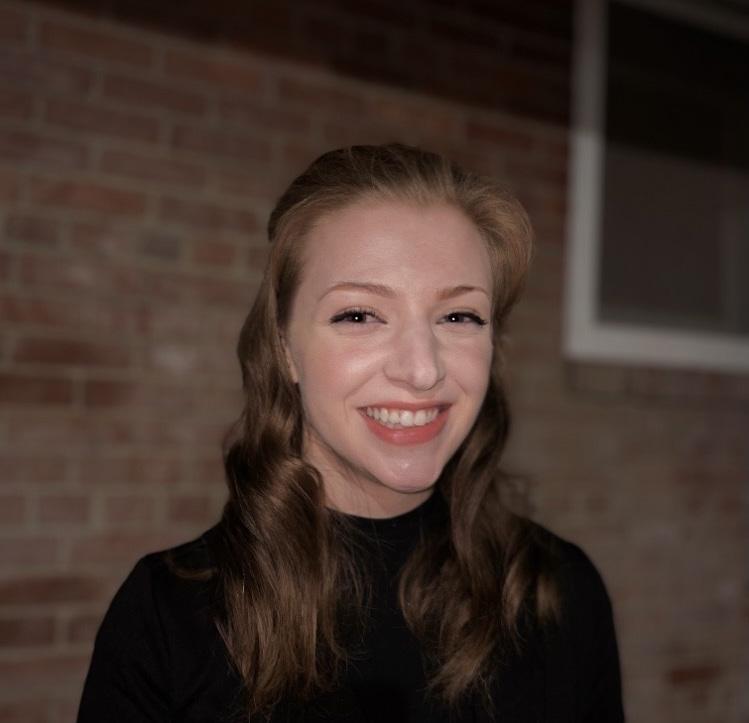
Editor's note: this story contains references to ableism and eugenics
“American University does not offer COVID-19 accommodations.” I’ve heard this a million times from administrators. This is the first semester to begin without mandated coronavirus precautions in classes since the pandemic started. As an immunocompromised student, it has made safely attending AU nearly impossible.
Immunocompromised students are left fighting for scraps of safety and contemplating whether we should be enrolled at all. According to the American Medical Association, 2.7 percent of the population is immunocompromised. Applied to AU’s enrollment population, that would proportionality be 401 students silently scavenging for professors and classmates who respect their right to survive the education they paid for when AU’s policies do not.
“If a member of our community asks others to mask when in close contact with one another, please treat these requests with respect and give them full consideration,” is the only line addressing immunocompromised students in each email lifting COVID-19 precautions. This is also the advice I’m given in personal emails with Bernard Schulz, the project manager for AU’s coronavirus response. There is no portion of any University correspondence about the coronavirus directing immunocompromised students to accommodations.
The Dean of Students Office told me in several meetings, though, that professors are allowed to provide unofficial accommodations. “Good news!” I thought. Except every professor I’ve asked has said their department head will not allow them to require masks or allow virtual attendance. The University has made sure immunocompromised students are blocked from safety at every turn. I am only kept safe by those willing to break the rules.
The past three semesters have started the same. I plan every class possible. I check Rate My Professors, looking for signs that the faculty aren’t too strict of rule followers. I email each professor the following, with hyperlinks to immunology journals and Centers for Disease Control and Prevention's recommendations:
Each of these are responses I’ve re-
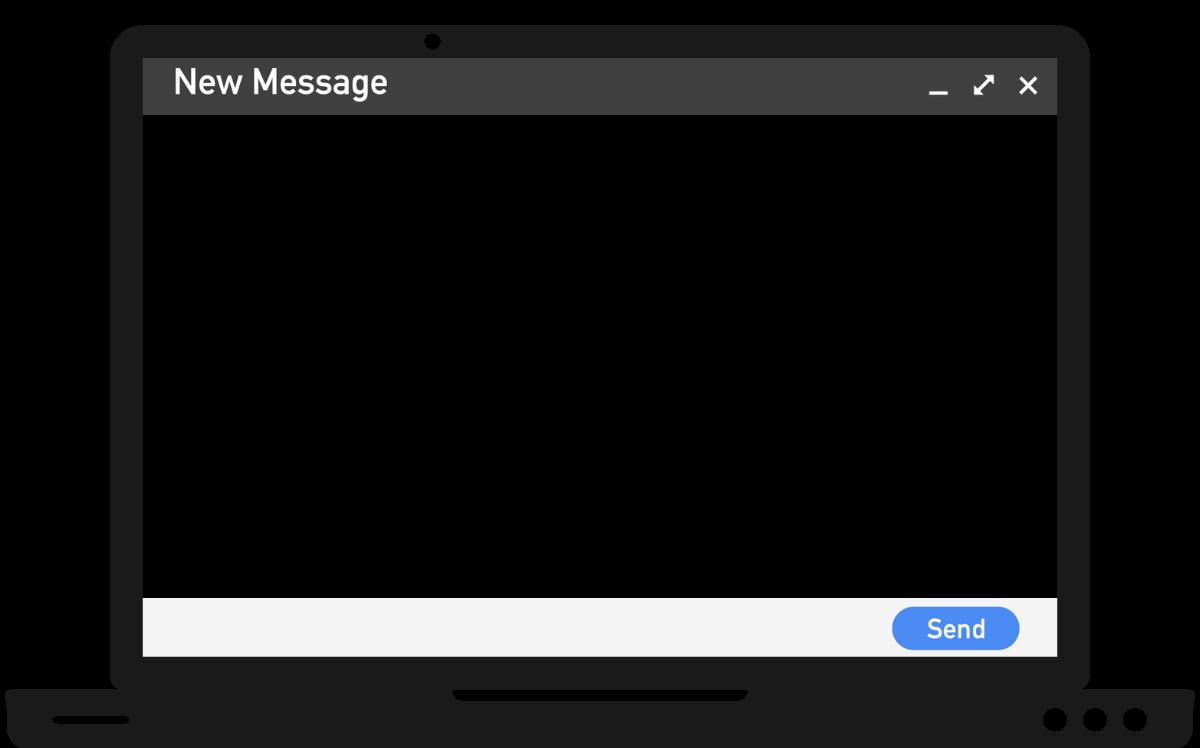
ceived:
“I require masks in class for this reason!”
“You can reach out to ASAC for accommodations.”
“I’m an adjunct, so I can’t bend any rules, as I might lose my job.”
“I will not be requiring masks in class. Hope this helps.”
When a professor is unwilling to teach me safely, I have to drop the class, even ones I desperately wanted to take. Lots of professors, luckily, do work with me. I’ve had professors who require masks the entire semester or give me a Zoom link. Some let me do the readings and assignments at home and have meetings during office hours instead. These accommodations are against AU’s rules. Everything that has made AU navigable as an immunocompromised student has been in spite of University leadership and policies.
This semester, the School of Communication has helped me. My last two classes in SOC were moved from small, windowless rooms with little ventilation to McKinley 100, an all glass room with two small rooms off to the side. I sit in one of those, 10 feet away from the nearest student.
I am grateful for the faculty members who pulled the strings to make this exception for me. This was a kindness, but not every class can be moved, nor is every department willing to help. University-wide policies make this support impossible to implement on a larger scale. Refusal to require masks or allow
virtual attendance as an accommodation has made physical segregation the bestcase scenario.
“Segregation — excluding [people] with disabilities — sets up an ‘us/them’ mentality and reinforces negative, stereotypical, and erroneous perceptions about individuals with disabilities,” writes disability activist Kathie Snow in her article, “Consequences of Segregation.” “Perceptions and attitudes are intertwined, and our attitudes drive our actions.”
Policies that segregate immunocompromised students let able-bodied students think we don’t deserve to be here.
I have personally begged my classmates to wear a mask, explaining my condition, buying masks and baking brownies to say thank you. They refuse, rolling their eyes and commenting on my social media, “What makes you think you deserve to live?”
AU’s only avenue for immunocompromised students is to be physically segregated, but segregation creates hostility. What happens when women and Black students are disproportionately immunocompromised?
Those assigned female at birth are four times as likely to have an autoimmune disorder, according to the National Institute of Health. Additionally, “Black students are overrepresented in nine of 13 disability categories and are more likely than their White peers to be placed in … exclusionary educational settings,” explain disability scholars Beth Ferri and David Connor.
These policies and attitudes communicate that immunocompromised students should either leave campus or not apply to AU in the first place. Students must have functioning immune systems and organs to safely attend.
To any immunocompromised students, if you contact the Disabled Student Union, you can find and add to a private spreadsheet I’ve started of particularly ableist, or accommodating, professors. I hope able-bodied community members will break AU’s rules and make it safe to attend, no matter what immune function one has.
22
Accommodation policies and apathetic attitudes effectively communicate that immunocompromised students should either leave campus or not apply in the first place.
Greta Mauch is a senior in the School of Communication and a columnist for The Eagle.
gmauch@theeagleonline.com
COURTESY OF GRETA MAUCH
/ THE EAGLE theEAGLE April 2023
GABBY ALLEN
Satire: Top 7 things AU students are looking forward to for summer break
Let’s stop pretending Joe Biden is your neighbor
by India Siecke Satire Columnist
The following piece is satire and should not be misconstrued for actual reporting. Any resemblance to a student, staff or faculty member is coincidental.
As wonks across American University’s campus are suffering from stress ulcers in the wake of finals, many look to the greener pastures of summer break for a glimmer of hope. The Office of Campus Engagement recently conducted a survey in an attempt to gauge which factors excite AU students the most about the upcoming break and remind us all of the light at the end of the tunnel. Here are the top seven activities AU students are most excited to do come May 10, most of which were a surprise to precisely no one:
1. Referring to D.C. as “the city” in their hick hometown. This answer was reported by 28 percent of students.
My brother in Christ, let's stop pretending Joe Biden is your neighbor; you live in Tenleytown. You are closer to Wegmans than the red line.
2. Paying under $15 for a shot. This answer was reported by 22 percent of seniors.
Sure, the bar will have an autographed picture of Rudy Giuliani and only play country/pop sung by neck-bearded tenors, but nothing tastes better than cheap feels! Fair warning, though, some bars will not allow every wandering, babyfaced 19-year-old to slip through the doors, so use that awful fake sparingly. Not every bar values your dollar over their liquor license.
3. Name-dropping Congress members they briefly interacted with during their Hillternship. This answer was reported by 17 percent of students.
Cory Booker made eye contact with you at Union Station because you had mustard on your chin, not because you’re the next AOC. Also, the most you’ve ever done to advance your pro-worker agenda was mute the constituent ten minutes into his thirty minute rant about how your moderate democratic state representative is a pawn for ANTIFA.
4. Cheating on their Georgetown situationship with their hometown sit-
uationship. This was reported by 12 percent of students.
A real Edward versus Jacob moment.
5. Complaining about their internship. This answer was reported by 9 percent of students.
What’s more fun than complaining about the classes you’re voluntarily paying a small fortune to take? Complaining about the internship acceptance you literally prayed for! After a grueling nine months of complaining about classes, complaining about an internship will be a breath of fresh air.
6. Eating a “real” bagel. This answer was reported by 8 percent of students.
As much as it pains the Seagle to acknowledge the so-called “state” of New Jersey, the people have spoken: there is nothing more important to them than the gluten product they have chosen to define them as a people. This answer wasn’t even a survey option, either. Those watered-down “Italians” abused our “other” section like their terrible fake tans abuse our
eyes.
7. Mansplaining the election for Speaker of the House. This answer was reported by 4 percent of students.
Our SPA-iest of Eagles are salivating at the mouth to explain to every innocent home friend or unsuspecting younger sibling the historical significance of Kevin McCarthy’s humiliating speaker election. While this event will be months old by the time summer comes around, everyone knows explaining political events aren’t about educating anyone: it’s about that sublime feeling of superiority. And the best part? You don’t even have to be a man to engage in mansplaining. As long as your attitude is pretentious enough, you’re golden.
Whether your parents are paying for your overpriced apartment in the city or you’re loitering around suburban America and working your part-time high school job: best of luck on your finals and, of course, HAGS.
India Siecke is a freshman in the School of Public Affairs and a satire columnist at The Eagle.
isiecke@theeagleonline.com
Satire: AU administration under fire as sentient flames claim new alarm system is discriminatory
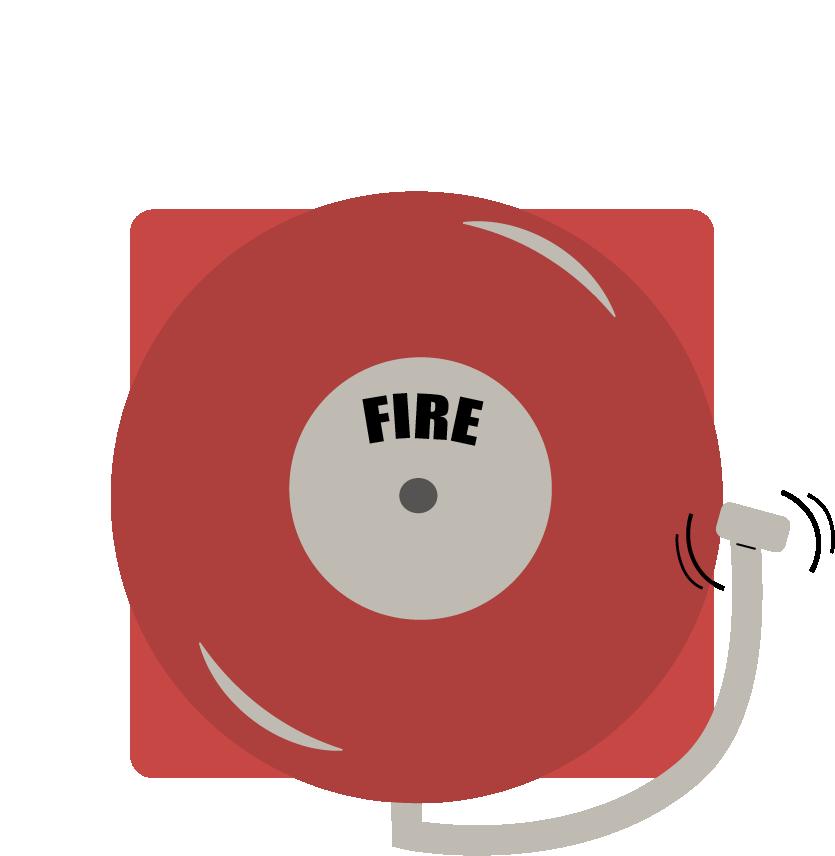 by Jared Bowes Satire Columnist
by Jared Bowes Satire Columnist
The following piece is satire and should not be misconstrued for actual reporting. Any resemblance to a student, staff or faculty member is coincidental.
American University’s new Positive Alarm Sequence requires personnel to respond to pulled fire alarms, inspect the scene and ensure the presence of an actual emergency. This new protocol for responding to pulled fire alarms has proven to be incredibly discriminatory. Following the implementation of the new system, local flames began protesting the personnel, who frequently declared them non-emergencies based on their height and hue.
In the immediate time following the initial rollout, no flames reported substantial changes in their typical lives. But as the rate of intentional alarm pulling ramped up, so did the flammable profiling. Reports of security personnel measuring flame height to assess the fire’s danger have flooded The Seagle’s office.
After one student’s dinner caught fire in a lounge, the Top Ramen flame ran to
pull the alarm, believing they were responsible. Curiously, no alarm sounded. Instead, about a minute and a half later, a man with a clipboard trudged his way over to the chicken-scented flame.
“What’s the reason for your creation, sir?” asked the man in a nasally, snobbish voice. The lanky man stood there with slumped shoulders, high-waisted khakis and a less-than-sunny disposition.
“Kid burnt his food,” claimed the flame. The man nod ded begrudgingly and did not hurry to declare an emergency. The flame grew impatient watching the cartoonish man con tinue to ignore this dire emergency and inquired about alerting the resident hall’s inhabitants. After a few judgy glares, the man bent down, whipped out a tape measure and measured the flame. After being told his flame did not meet the height requirement for an actual emergency, the flame became irate and exploded away.
Last month, a first-year student tried
to microwave a metal bowl, and the system discredited the flame due to the clarity of their orange hue.
The flame met with Seagle reporters to share their story with the campus. Through a painful recounting of events, they claimed the worker tasked with the fire’s severity deemed the fire “incapable of damage” because the flame was “not orange enough.”

After the University revealed the tremendous backlog of reports of these failed fires, mounting complaints from flames across campus caused a whirlwind, as flames refused to leave until they were deemed emergencies. All attempts at extinguishing these protests have proved futile. The flames have left their mark on campus, in both the figurative and literal sense.
In an attempt to quell the fiery discontent, administrators released a series of statements throughout the
semester. While these statements purport to “reevaluate” criteria for defining firerelated emergencies, the flames have yet to be convinced.
In fact, the flames were so dissatisfied with the performative statement, they lashed out. As of last week, the campus remains entirely engulfed in flames. Students are dying. Buildings are burning. The entire recorded history of the University is being loudly charred to bits by the roaring protests of profiled flames.
The University’s administration maintains its position. When interviewed by a Seagle reporter in a flame-proof box, one flame said, “This new system has brought burning questions to administration in the fields of discrimination, safety and consistency. We won’t back down until this whole place is charred to the ground.”
Evidently, neither will the administration. The Seagle expects more fiery protests and fuming students in the weeks to come.
23
jbowes@theeagleonline.com theEAGLE April 2023
Jared Bowes is a freshman in the School of Public Affairs and is a satire columnist for The Eagle.
!! !
GABBY ALLEN / THE EAGLE
AU's lack of faculty diversity reveals wider issues
University's inclusive excellence plan falls short for increasing student sense of belonging
by The Eagle Editorial Board
Professors of color are disproportionately underrepresented across the country. American University is no exception to this. As The Eagle examined faculty diversity around campus, what we found was unsatisfactory. Although each school within AU has a disappointingly low number of faculty of color, some schools lack more than others.
The biggest culprits? The School of Public Affairs and the School of Communication.
Only 15 of the 111 full-time SPA faculty members identified as persons of color for the 2021-2022 academic year. This number is likely a symptom of a much larger problem than just AU’s hiring practices. Since the inception of the United States, the federal government has been dominated by white men. Although the government has become more diverse in recent years, the effects of decades of racial discrimination in hiring practices directly influence the current job market. Because many SPA faculty are hired due to their experience in government and law, it tracks that white people are dominating the job market. This is systemic.
Similarly, only 15 percent of full-time SOC faculty members identify as persons of color. This percentage, unfortunately, is in line with the journalism industry as a whole. The Columbia Journalism Review found that racial and ethnic minorities compose only 17 percent of U.S. newsroom staff. This causes an identical issue to SPA. The government and journalism industries must improve their hiring practices to diversify their talent. In doing so,
DOWN
1. Subject of The Eagle's latest TikTok series (@theeagleonline)
3. Singer whose tour is not stopping in DC
4. Former One Direction member who celebrated St. Patrick's Day at the White House
5. What an AU sports team is in the Patriot League
7. Prison abolitionist who spoke at AU
9. School of ____ (AU college with the highest percentage of non-white faculty)
11. Popular TikTok format, abbr.
13. Part-time occupation of many AU students
14. Everything Everywhere All at Once swept at this awards show
15. Tenleytown native known as "the science guy"
19. What you're looking for in this puzzle
21. Alias, abbr.
22. AU school that houses contemplative philosophy majors
ACROSS
2. ___ by ____, The Eagle's sports podcast featuring student athletes
4. Month that escalator construction is supposed to be completed at the Tenleytown metro station
6. Object to be snoozed before your 8:10 am class
8. Tub, also found in Letts (in French)
10. Online marketplace where some AU students re-sell clothing
12. Functioning well
universities will have more diverse candidates.
This is not to absolve AU of blame, however, for the lack of diversity in faculty. AU must make more of an effort to close this hiring gap. In its Diversity, Equity, and Inclusion Statement, AU recognizes the importance of a diverse faculty. The fourth step of goal 4 of the Inclusive Excellence plan is to “continue efforts to diversify faculty hiring and retention.” There are specific steps listed to achieve this, yet based on faculty demographics, it seems that either the plan has not been implemented or it is not working.
The Kogod School of Business has a hiring program specifically designed to diversify faculty. Thirty-three percent of Kogod’s full-time faculty are racial or ethnic minorities, the second highest of any AU school. While this percentage should still be improved upon, it shows that a white-dominated field, like business, can still produce a diverse hiring pool. Other schools, like SPA and SOC, should look to Kogod to see how they can improve.
AU’s advertisements, emails and social media campaigns are flooded with the phrase “inclusive excellence.”
Students who come to AU expecting to find faculty members with shared identities due to this campaign should not have to be disappointed when they show up to class. Students of marginalized identities should be able to see themselves represented in the classroom, regardless of what major they choose. Unless every student can have professors with which they share commonalities, “inclusive excellence” will just be a buzzword that gives students unrealistic expectations.
Students have a role to play in this, too. By filling out the Campus Climate Survey, students can let AU know what is and isn’t working and how they feel about AU. The
Inclusive Excellence Plan was a direct result of students’ responses in the 2017 Campus Climate Survey. Students often complain that the University isn’t listening to them, but the University has no way of knowing how we feel unless we tell them. The Campus Climate Survey is a chance to do this. Students should give the Campus Climate Survey the same energy we give the end-of-semester Student Evaluations of Teaching for professors. This is our chance to make our voices heard and we shouldn’t ignore it.
Once the Campus Climate Survey has been filled out by students, the University needs to make the results public and clearly explained so students can see if their complaints have actually been addressed. It is one of many ways administration can become more transparent.
Students want to be heard, but after years of being told that we should just go through the 'proper channels' — filling out surveys, sending emails or applying to join working groups — to do so, it becomes tiring when we don't see the results of those actions. The University needs to show students that our feedback is not being thrown in a filing cabinet to never be seen again, and that it is actually being taken to heart.
Students and faculty are more than just business transactions. Improving faculty diversity can only lead to more students feeling represented and comfortable in class, leading to greater success in the future.
Faculty are often a student's first impression of what an industry looks like, and by not having diverse faculty, the University is showing its students of color that they will not be valued in their chosen fields.
editor@theeagleonline.com
16. Page with photo of a hand raised
17. Most popular place to see cherry blossoms
18. Administrator who recently left AU after 30 years
20. DC public ___, added new stops on the silver line
23. Student group that proposed a green new deal for AU
24. BANG!, maybe
25. Typical April weather
26. Common driving maneuver in Ward Circle
27. AU alumna who spoke on campus for Trans Day of Visibility
CROSSWORD BY IZZY FANTINI, NINA HELLER, CARLY JOHNSON
theEAGLE April 2023
CROSSWORD STAFF EDITORIAL 1 2 3 4 5 6 7 8 10 11 12 13 14 15 16 17 18 19 20 21 22 23 24 25 26 27 9






 by Kathryn Squyres News Staff Reporter
by Kathryn Squyres News Staff Reporter









 – Kat Raiano
– Kat Raiano

















 by Jared Bowes Satire Columnist
by Jared Bowes Satire Columnist
